
The Project Gutenberg EBook of Key and Guide to Native Trees, Shrubs, and Woody Vines of Dallas County, by Norma J. Stillwell This eBook is for the use of anyone anywhere in the United States and most other parts of the world at no cost and with almost no restrictions whatsoever. You may copy it, give it away or re-use it under the terms of the Project Gutenberg License included with this eBook or online at www.gutenberg.org. If you are not located in the United States, you'll have to check the laws of the country where you are located before using this ebook. Title: Key and Guide to Native Trees, Shrubs, and Woody Vines of Dallas County Author: Norma J. Stillwell Release Date: January 16, 2019 [EBook #58703] Language: English Character set encoding: UTF-8 *** START OF THIS PROJECT GUTENBERG EBOOK NATIVE TREES, SHRUBS, AND WOODY VINES *** Produced by Stephen Hutcheson and the Online Distributed Proofreading Team at http://www.pgdp.net

by
NORMA STILLWELL
Dallas, Texas
April, 1939
PRINTED BY
PROCTOR-ADAMS PRINTING SERVICE
DALLAS, TEXAS
This simple key and guide to the woody plants—trees, shrubs and woody vines—which grow naturally in Dallas County, Texas, has been prepared to help beginners of any age in getting better acquainted with these leafy neighbors and friends. Woody plants offer one of the best places to begin a study of nature: first because there are but few kinds to learn in comparison with many other living forms—about 90 of these plants against estimated numbers for the county of about 300 birds, 500 to 1000 other flowering plants and over 25,000 insects; second, woody plants remain in one place, freely available for observation at any hour or season and year after year—if they escape human interference. And what more helpful link toward acquaintance with other interesting forms of natural life can be found than an intimate friendship with their mutual friends, the trees!
The distinctions between trees and shrubs or between shrubs and woody vines are often purely arbitrary, depending in part on age. A plant which grows at least twenty feet tall and usually (not always) has just one woody, self-supporting stem at the ground is considered a tree. A plant which rarely grows taller than twenty feet, in a given region, and usually has more than one woody stem rising from the ground is considered a shrub. The separation of herbs from woody plants divides those plants which usually die down to the ground each winter from those having woody stems which persist above ground year after year. Some ninety different woody plants are distinguished from one another and briefly described in this key and guide. Each description represents a single species with the exception of the cactus, yucca, red oaks and red haws; the differences between the various species of these plants are too complex for this brief manual.
Scientific names are included here, not with any thought that they should be memorized or that they need be used in ordinary conversation, but to avoid the possibility of misunderstandings such as often arise from some common names which are used by different persons to designate different plants. Many plants have more than one common name and often one common name is used for two or more quite unlike plants. Common names listed first are the ones considered more suitable.
The first part of the scientific name represents the genus (plural, genera), a degree of relationship or grouping smaller than the family but more inclusive than the species. The second name represents the species or specific kind of plant; species are occasionally divided into varieties (var.). The abbreviation following the scientific name stands for the name of the botanist who first described or named the plant, scientifically. L. stands for Linnaeus, “the father of modern botany”, who first used this double-name (binomial) system of scientific classification.
More extended descriptions and further information about these plants may be found in some of the reference books listed in the back of this booklet; many, if not all of them, are available in the Dallas Public Library. Only the more necessary technical words have been used and these are defined or illustrated herein. Although this booklet endeavors to include all the woody plants growing naturally in Dallas County, no doubt omissions and errors will be found and the author will be glad to be informed of them.
Grateful acknowledgement is made to Dr. W. M. Longnecker and Dr. E. P. Cheatum of the Department of Biology, Southern Methodist University, and to Dr. B. C. Tharp of the Department of Botany and Bacteriology, University of Texas, for their most helpful suggestions and criticisms. Although this booklet is based upon the field observations of the author and her husband, Jerry E. Stillwell, who assisted her in many ways, she has made free use of such technical information as was needed from the volumes listed in the bibliography.
The illustrations used in this publication were drawn for it by Alice Ferguson.
NORMA STILLWELL, Dallas, Texas.
Copyright 1939 by the author.
This key is based chiefly on leaves and twigs, as they offer the easiest clues for identification, especially in this climate where leaves are present about three-fourths of the year. The best method of study is to carry this booklet to the woody plant or plants you want to know. If this is not convenient, have at least a leafy twig in hand. When collecting specimens for study (a large-paged magazine will do for carrying and pressing), notes should include the date and location, any peculiarities of the bark, nature of thorns if not on the specimen taken, color of twigs or any other features which might change in drying, flowers or seeds or any such extra clues which might help to find the right name for the plant. Small specimens of leafy twigs may be taken in suitable locations without endangering or damaging woody plants provided they are always cut, never torn from the branches.
The sizes as well as shapes of leaves are usually more typical on older plants or on the higher branches of trees. When either leaves or twigs are described as opposite, this condition will be found to be true for both, although sometimes the opposite member is missing; but leaflets (leaf-like units of a compound leaf) may sometimes be opposite when the complete leaves are not—the position of leaves, not leaflets, is used in this key. The terms rare, common or abundant are used to apply solely to Dallas County.
Begin with the numbers 1 in the key and decide which of these fits the woody plant whose name you are seeking. Turn to the key number following the 1 you have chosen and again choose between the two descriptions bearing the same number. Continue this process until you have reached the name of a plant. This name will be followed by some number above 200; turn to this number in the guide and see whether this more complete description fits. If each of your choices in the key has been correct you now know the name of your plant. If this description in the guide does not fit your plant, go over the key again, selecting this time the other choice at any number where you may have been in doubt.
Whenever it has been necessary to use an obscure or variable characteristic an effort has been made so to arrange the key that the right answer will be reached whichever the choice. That is why some plant names appear more than once in the key. If the following points 5 are noted any careful observer should be successful in identifying the native woody plants of Dallas County by the use of this key. It will be found helpful in other regions where the native plants are similar to those of Dallas County.
1. Look carefully for thorns or prickles.
2. Notice anything unusual about the bark of trunk and branches—knotty, flaky, peeling, color, etc.
3. Try to choose mature leaves of typical shapes and sizes rather than the unusual ones.
4. Look for flowers, fruits or seeds on or under a tree or other woody plant. These may furnish just the confirmation you need to feel sure of the right name.
axil: the angle where a leaf stem joins a twig.
deciduous: losing its leaves in winter, not evergreen.
dioecious: bearing staminate, or male, flowers on separate plants from the pistillate, or fruit-bearing flowers; hence some plants of certain species never bear fruits or seeds.
fruit: that part of any plant which contains the seeds.
lenticel: air pore in the bark.
monoecious: bearing the two kinds of flowers on the same plant.
opaque: not admitting or transmitting light.
perfect: having both stamens and pistils in one flower, as most showy flowers have.
pistillate: possessing a pistil or pistils and lacking stamens; female, or fruit-bearing.
staminate: possessing stamens and lacking a pistil; male, or pollen-bearing.
translucent: admitting some light but not clear or transparent.
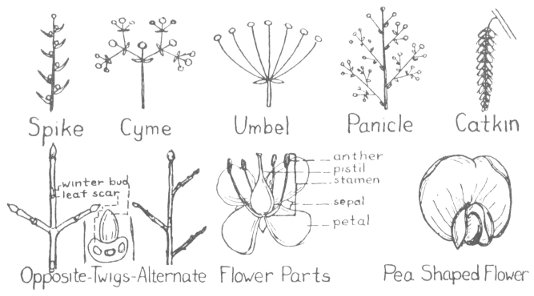
FLOWERS and TWIGS
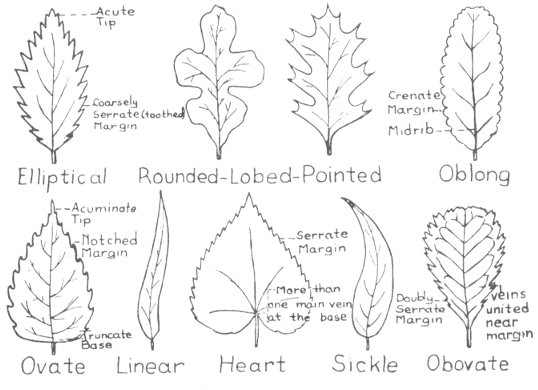
TYPES OF SIMPLE LEAVES
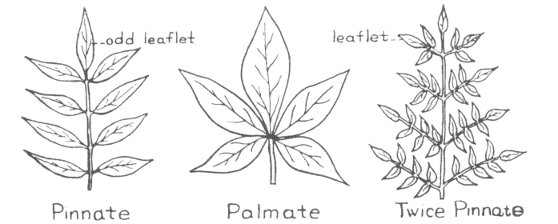
COMPOUND LEAVES
Numbers below 200 refer to the key,
above 200 to the guide (p. 20).
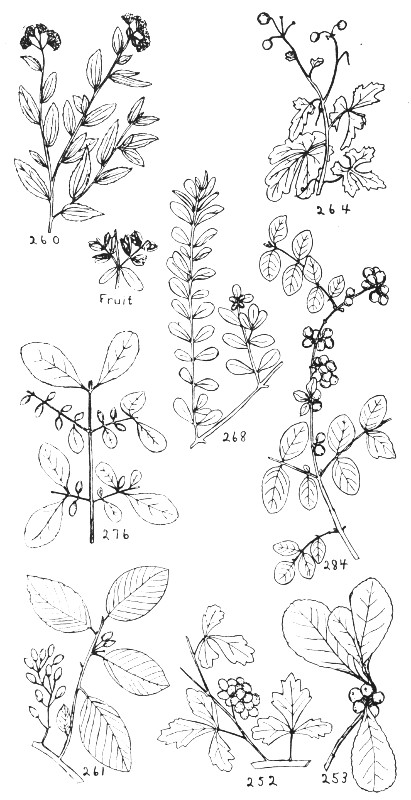
about ½ natural size
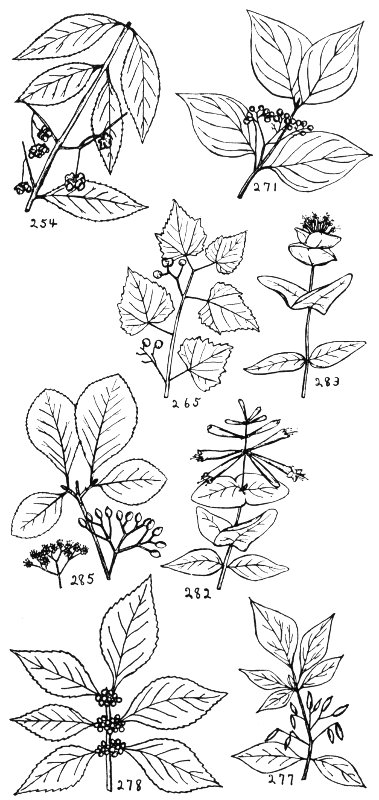
about ¼ natural size
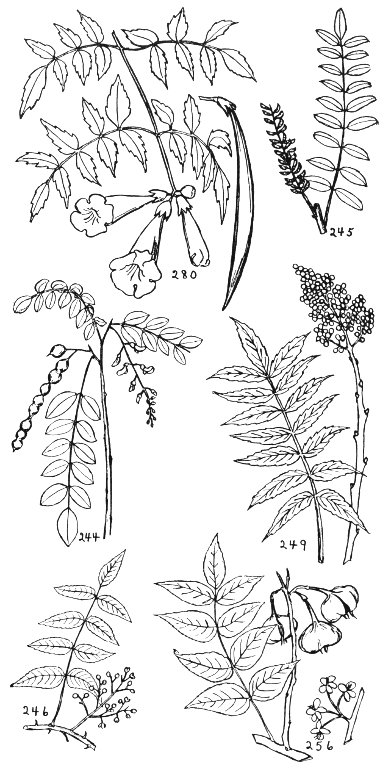
about ¼ natural size

about ¼ natural size
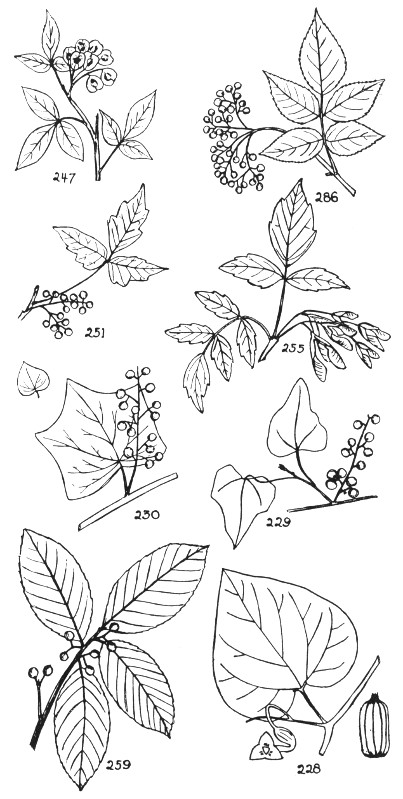
about ¼ natural size
Capital letters and page numbers following the descriptions of a few of these plants refer to the bibliography at the end of this guide.
201. RED CEDAR (Juniperus virginiana L.) abundant tree of medium height. Habitat: all soils, especially limestone hills in southwestern part of county. Leaves: small, thick, scale-like or like short needles. Bark: thin, reddish brown, shreddy, inner layers yellowish brown. Twigs: of young shoots bear the sharper-pointed leaves. Flowers: dioecious, in February or March; staminate minute, numerous, rusty; pistillate purplish, inconspicuous. Fruit: light blue, spherical, ¼ inch diameter. Wood: reddish at heart, sapwood light, used for cedar chests, rustic work, and fence posts; for the last inferior only to bois d’arc as it is very lasting in contact with the soil.
202. MOUNTAIN CEDAR (Juniperus mexicana Spreng.) rare tree except at Camp Wisdom and vicinity. Habitat: dry uplands, this about its eastern limit but abundant westward. Leaves: similar to red cedar. Inner bark: darker brown than on red cedar. Fruit: larger and darker than red cedar, purplish. Wood: light brown, hard and close-grained but weak, used for fuel, fence posts, poles and landscape planting.
203. DWARF PALMETTO (Sabal minor Pers.) low shrub of the river bottom, rare. Leaves: 15 to 20 inches long, spreading, fan-shaped, from an underground stem; browsed by cattle and mostly destroyed when Bois d’Arc Island was cleared for cultivation. Flowers: whitish, small, from a slightly branched central stalk. Fruit: black, spherical, smooth, dry, about ¼ inch across. L (p. 223) (S. glabra). M (p. 240.)
204. GREENBRIER (Smilax bona nox L.) abundant vine; locally called stretchberry, saw-brier, cat-brier. Habitat: woodlands and thickets, becoming especially obnoxious in heavily pastured woodlands. Leaves: 1½ to 4½ inches long, ½ to 3 wide, alternate, oval or somewhat heart-shaped, margins entire; smooth, thick, shining, many remaining green and some mottled with brown in 22 winter; all primary veins running lengthwise of leaf. Stems: long, evergreen, often very prickly, climbing by tendrils. Flowers: small, inconspicuous, yellowish or greenish, dioecious, in umbels, six “petals”. Fruit: black, shining or covered with a bloom, round or nearly so, size of small peas. This vine’s greatest virtue seems to be that it offers food and shelter to the birds.
205. YUCCA, bear-grass, Spanish dagger (Yucca species) more than one species in the county; abundant in meadows and along roadsides. Leaves: grasslike but large, thick and tough, in rosettes, often with white threads on margins; sharp-pointed. Woody stem: very short in our species. Flowers: greenish white or creamy, many along a central stalk two or three feet tall; each cupped flower about an inch or two long, fertilized by a small white moth which lays its egg inside. Fruit: a short, thick, cylindrical pod containing layers of flat, black seeds.
206. WILLOW (Salix nigra Marsh.) the black willow is probably the only native species growing in the county. The weeping willow (Salix babylonica) has not been observed growing in the county except where planted. Willows grow close to water or in low ground, are very common and grow very rapidly where they have an abundant supply of water; very valuable in checking soil erosion as their roots help to hold the soil in place. Leaves: simple, alternate, 3 to 6 inches long, ⅛ to ¾ wide, acuminate, with fine, incurved serrations. Bark: rough, shaggy on old trees, usually light brown. Twigs: conspicuously yellowish orange in winter, smooth or glossy, very slender. Flowers: in catkins, yellowish, dioecious. Fruit: cottony-covered seeds. Wood: soft, light, weak, used for a special charcoal in manufacturing gunpowder, some species for artificial limbs.
207. COTTONWOOD (Populus deltoides var. virginiana Sudw.) common, large tree, also called Carolina poplar. Habitat: prefers lowlands and stream banks although will grow in dry soil. Leaves: simple, alternate, 3 to 5 inches each way, commonly glossy on both sides, broad and straight across at the base, coarsely toothed or crenate, stems flattened. Bark: thick, light gray, deeply furrowed on trunks to smooth and yellowish green on branches. Twigs: stout, greenish yellow to pale gray, smooth; lenticels large, pale, lengthwise; buds large, scales very sticky-resinous. Flowers: staminate are red catkins, pistillate greenish yellow, dioecious. Fruit: 23 cottony-covered seeds. Wood: soft, light weight, warps easily but cheap because of rapid growth of tree; new methods of rapid kiln-drying have lessened warping.
208. BLACK WALNUT (Juglans nigra L.) tree, common in rich bottomlands. Leaves: alternate, pinnately compound, one to two feet long, 15 to 23 leaflets, each about 3 inches long, tapering and toothed; with a characteristic odor when crushed. Bark: thick, dark, rough. Twigs: have dark, chambered pith shown by splitting lengthwise through center. Flowers: greenish, male in catkins, female inconspicuous, both kinds on the same tree. Fruit: green to black husk does not split, round; shell rough, very hard, dark; nut rich and sweet. Wood: hard, strong, rich brown color, very valuable for gunstocks, furniture, etc.
209. PECAN (Carya pecan Engl. & Graebn.) abundant, the state tree. Habitat: rich bottomlands preferred. Leaves: similar to black walnut but average fewer leaflets, 9 to 17. Twigs: do not have dark, chambered pith. Bark: somewhat variable in appearance but generally lighter in color than walnut and not as flaky as soapberry both of which it resembles. Fruit: very valuable crop in Texas, many cultivated varieties tending toward larger size of nuts and thinner shell. Wood: not valuable, hard but brittle and not strong.
210. BITTER PECAN (Carya texana Schn.) rare tree of low woodlands. The nuts are 4-angled and the seeds bitter. Wood tough and strong.
211. HICKORY (Carya buckleyi Durand) uncommon in this county. Observed in sandy woods. Leaves: pinnately compound, of 5 to 9 leaflets, the terminal 4 to 6 inches long, 2 to 2¼ wide, twice as large as the lowest, obovate and tapering at each end. Bark: dark, rough, close. Fruit: resembles pecan but broader; shell thick, somewhat wrinkled, light in color; seed sweet. Wood: hard, brittle, little used except for fuel.
White Oak Group: Fruit requires 1 year to mature; leaves without sharp points to lobes (except chinquapin oak leaves). Bark: usually lighter gray than on black or red oaks.
212. POST OAK (Quercus stellata Wang) most abundant tree of dry, sandy, upland woods. Leaves: 3 to 5 inches long, with 5 rounded lobes wider toward the 24 outer end; like bur oak but smaller; dead leaves often cling in winter, especially on young trees. Flowers: as in other oaks, male in catkins, female inconspicuous, both kinds on same tree. Fruit: an oval acorn, ½ to 1 inch long in a rather shallow cup. Bark: rough, with deep grooves. Twigs: very fuzzy when young. Wood: hard, durable in soil but difficult to season, used mainly for fuel, fence posts and crossties.
213. SCRUB OAK: or dwarf post oak (probably a variety of Q. stellata). Habitat: on limestone hills where common. Leaves: similar to post oak but less than 3 inches long and less deeply lobed. Bark: thin, light gray, with loose scales. Sometimes attains tree size though usually shrubby and growing in dense thickets, typically not over 20 feet high.
214. BUR OAK or mossy-cup oak (Quercus macrocarpa Michx.) common large tree of lowlands; heavy, thick branches make it the sturdiest looking of our oaks. Leaves: 6 to 12 inches long, deeply 5 to 7 lobed with the lobes rounded and larger toward the tip, upper lobe largest and wavy margined or shallowly lobed. Acorns: large, 2 inches or more in diameter, the cup usually deep and heavily fringed. Wood: for cabinetmaking and all sorts of construction, shipbuilding, etc.
215. SWAMP CHESTNUT OAK or basket oak (Quercus prinus L.) Habitat: rich bottomlands, not common. Leaves: obovate, margins deeply wavy or with small, regularly rounded notches, downy beneath, 3 to 8 inches long. Bark: light gray, with broad flakes. Acorns: about 1½ inches long by 1 inch wide, shiny brown, with a shallow cup, eaten by cows (cow oak). Wood: used for lumber, veneer, cooperage, wheels, implements, and baskets.
216. CHINQUAPIN OAK or chestnut oak (Quercus muehlenbergii Engelm.) Habitat: various, prefers limestone soil, common. Leaves: similar to preceding species but more sharply notched. Bark: thick, usually silvery gray, large, loose scales on surface. Acorns: smaller than preceding and have very short stems. Branches: typically fewer, larger and more irregular than preceding. Wood: hard, strong, close-grained, durable, used for cooperage, furniture, crossties, fuel.
25Black or Red Oak Group: Fruit requires two years to mature, leaves have sharp points on lobes.
217. WATER OAK, duck oak, or pin oak (Quercus nigra L.) Habitat: low, sandy land, rare. Leaves: usually about 2½ inches long and 1½ wide, narrow toward base, usually broader toward tip, shallowly lobed toward tip or entire, smooth and dark green above, tardily deciduous. Bark: rather smooth, reddish brown. Fruit: acorns usually solitary, very short-stalked, light brown, ½ to ⅔ inch long. Wood: heavy, hard, strong, little used except for fuel and crossties.
218. BLACK JACK OAK (Quercus marilandica Muench.) Habitat: dry, upland woods, sandy soil, with post oaks where few other trees grow, common. Leaves: 4 to 10 inches long, very wide at tip, narrow toward base, only very shallowly lobed, dark above, leathery, dead leaves often clinging to young trees in winter. Bark: rough, dark, broken into small, hard flakes. Fruit: an acorn about ¾ inch long with a cup enclosing about half the nut which is yellowish brown and often striped. Wood: heavy, hard and strong but little used except as fuel.
219. RED OAK (Quercus species). Several species of red oak are not easily distinguished except by specialists and the problem is complicated by the fact that many species interbreed readily, thus producing many variations from the typical forms. Probably Q. shumardii var. schneckii is the most common red oak around Dallas. The leaves are similar in shape to the black oak but are thinner and lack the prominent rusty hairs in the forks of the veins; lobes are usually from 5 to 7 and vary greatly as to length and width. The Texas red oak (Q. texana Buckley) is a closely related smaller tree of dry uplands. The Spanish oak (Q. rubra L.) is another red oak of dry uplands; it is easily recognized when the leaves assume one typical form which is narrow and rounded at the base with the three or more narrow lobes occurring near the tip. For more complete descriptions of these trees the reader is referred to the latest edition of Sargent’s “Manual of the Trees of North America.”
220. RED OR SLIPPERY ELM (Ulmus fulva Michx.) Habitat: principally in rich soil on low hillsides or stream banks, a common tree. Leaves: doubly toothed, unequal at the base, 3 to 7 inches long, rough on both sides. Twigs: somewhat mucilaginous or “slippery” when 26 chewed; buds covered with rusty hairs. Inner BARK: very mucilaginous, used in medicine; outer BARK: grayish brown with flat ridges. Flowers: small, inconspicuous, appearing very early in spring, before the leaves; in clusters, each flower on a long drooping stalk. Fruit: green-winged seeds, disk-shaped, notched at tip but without incurved tips. Wood: close-grained, tough, heavy, hard, used for fence posts, crossties, implements, ribs for small boats, etc.
221. WHITE OR AMERICAN ELM (Ulmus americana L.) Habitat: similar to red elm, less common. Leaves: similar except usually rather smooth above and downy below, veins prominent below and parallel from midrib to leaf edge. Twigs: brownish and smoother, buds without rusty hairs, not, or very slightly, mucilaginous. Cross section of BARK shows alternate layers of brown and white; surface dark gray with irregular, flat-topped ridges. Flowers: very short-stalked. Seed: wings notched, with incurving tips. Wood: hard, strong, tough, difficult to split, coarse-grained, used for wheel-hubs, saddletrees, floors, boats.
222. CEDAR ELM (Ulmus crassifolia Nutt.) Habitat: varied, our most abundant elm, resists drouth and root rot, hence recommended as a shade tree. Leaves: 1 to 2 inches long, usually blunt tipped. Young TWIGS: reddish and slightly downy, sometimes have corky wings. Flowers and Fruit: in late summer and early autumn. Branches: relatively short and numerous, making dense shade in spite of small size of leaves. Wood: brittle, sometimes used for hubs, furniture and fencing; mostly for fuel and charcoal.
223. WINGED ELM (Ulmus alata Michx.) Usually found on low, sandy land; not common. Leaves: 1½ to 3 inches long, pointed at the tip. Twigs: usually with many broad, corky wings, though sometimes absent. Flowers: in spring. Wood: similar to other elms.
224. ROUGH-LEAVED HACKBERRY (Celtis occidentalis var. crassifolia Gray). Habitat: varied, more common on rich soil. Leaves: ovate, toothed at least toward the long point, 2 to 4 inches long. Fruit: a roundish, dark purple berry ripening in early fall, often clinging to the tree through the winter and forming a popular food for many birds; about ¼ inch in diameter. Bark: of trunk usually conspicuous with its characteristic warty projections. Wood: heavy but soft and weak, decays rapidly when exposed, little used except for fuel. The 27 characteristic brown gall on the twigs is almost a mark of recognition in winter, when trees are too small to show the typical warty bark.
225. SOUTHERN HACKBERRY (Celtis laevigata Willd.) Less common than previous species. Distinguished by the smooth margins of the slightly longer and narrower LEAVES and by the orange or yellowish color of the FRUIT. Both trees are widely planted for shade as they are resistant to root rot.
226. BOIS D’ARC OR OSAGE ORANGE (Maclura pomifera Schn.) also called horse-apple. Abundant in rich bottomland. Leaves: entire, dark green and glossy, oval, pointed at tip, 3 to 5 inches long. The yellowish-brown BARK distinguishes it from any other thorny tree, contains tannin and that of root a yellow dye. Flowers: monoecious, the female in a rounded ball, male in an elongated cluster. Fruit: resembles a very rough, large, bright green orange. Wood: bright orange in color, most durable in contact with the soil, used principally for posts.
227. RED MULBERRY (Morus rubra L.) Common in rich lowlands, often in the shade of larger trees. Leaves: 3 to 5 inches long or rarely much larger in dense shade, toothed, ovate, pointed at tip, rounded or heart-shaped at base; on young trees often mitten-shaped or deeply and variously lobed, rough above. Flowers: monoecious or dioecious, in drooping catkins, the female shorter. Fruit: red to black, resembles blackberry, ripens through May, very attractive to many birds, especially the migrating thrushes. Bark: thin, dark grayish brown, breaking into long scales. Twigs: slender, somewhat zigzag, with milky juice. Wood: light, soft, weak, used for fence posts, cooperage and boat building.
228. WOOLY PIPEVINE (Aristolochia tomentosa Sims.) or Dutchman’s pipe. Habitat: low, rich woods, not abundant. Leaves: large, round-heart shaped, downy, soft, margins entire. Stems: slender, very high climbing. Flowers: tube u-curved like a Dutchman’s pipe, with lobes turned back; small yellowish, inconspicuous flowers not to be confused with the leather flower (Viorna) which is also sometimes called pipevine; Viorna has four thick, leathery, purplish petals shaped like the bowl of a 28 pipe. Fruit: many flat, black, shiny, pie-shaped seeds packed in a six-angled, cylindrical seed case about 1 to 2 inches in diameter and 2 to 3 inches long. A closely related cultivated vine is often planted where a dense screen is desired. B (Vol. I, p. 646).
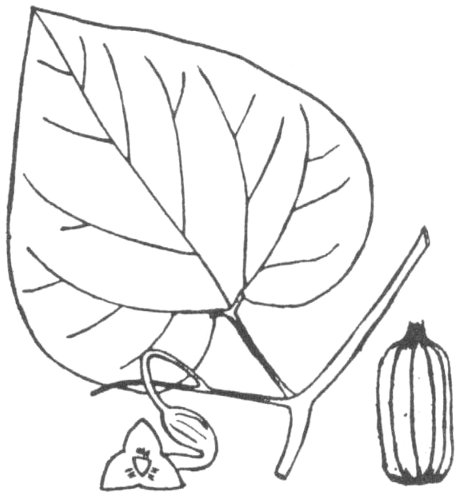
228 wooly pipevine
229. CAROLINA MOONSEED (Cocculus carolinus (L) DC.) also called wild sarsaparilla or coral vine. Habitat: hedgerows and thickets, edges of woods, a common vine. Leaves: variable, oval to slightly heart-shaped, usually blunt or rounded at the tip, usually about 2 or 3 inches long. Stems: slender, green and somewhat fuzzy when young. Flowers: dioecious, small, greenish, 6-parted. Fruits: size of small peas, soft, scarlet, one-seeded, in small, dense clusters; very decorative in winter and excellent bird attraction.
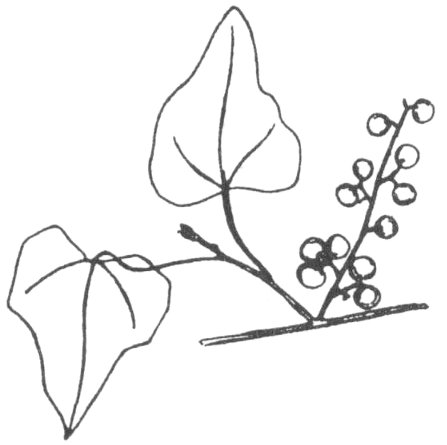
229 Carolina moonseed
230. CANADA MOONSEED (Menispermum canadense L.) very rare vine of low woods. Stems: 6 to 12 feet long. Leaves: 3 to 7-angled or shallowly lobed, broader than long, 4 inches or much more. Flowers: small, white, 6-8 petals, 12-24 stamens. Fruit: black with a bloom, resembling small grapes; seed spirally curved. B (Vol. II, p. 131).
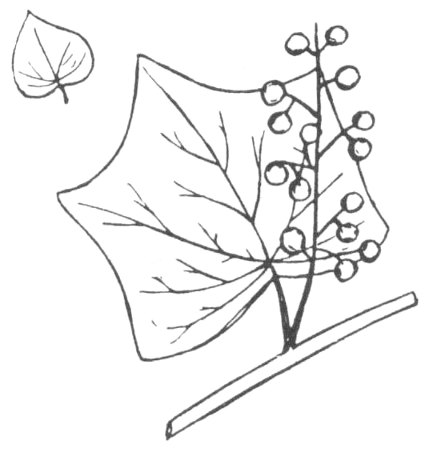
230 Canada moonseed
231. SYCAMORE or buttonwood (Platanus occidentalis L.) a common tree, along stream banks and in low woods, often the largest tree in its locality as it grows rapidly. Bark: thin, smooth, greenish gray, flaking off in large patches and exposing the under bark which is whitish like that on limbs, especially conspicuous in winter woods. Leaves: 4 to 7 inches long and about as broad, very coarsely toothed, often shallowly 3 or 5-lobed, light green above, paler below. Twigs: slender, rather shiny and zigzag; bud with a single, cap-like scale, enclosed by the base of the leaf-stalk. Fruit: a compact ball about 1 inch across, remaining on its drooping stem all winter, composed of many seeds which separate and are blown away in spring. Often planted as street tree because of rapid growth and resistance to drouth, but the large leaves and flaking bark cause unsightly litter. Wood: coarse-grained, hard, not strong, heavy, hard to split; used for butchers’ blocks, furniture, interior trim, and tobacco boxes.
232. RED HAW or hawthorn (Crataegus species) probably about four species in the county. Three are easily distinguished by the shapes of the leaves and the size of the fruits:
(a) Leaves: very wooly when young, broad near base and nearly as broad as long, doubly toothed and often shallowly lobed; especially susceptible to the cedar rust. Fruit: red, resembling large rose hips, edible, mealy, about ¾ inch across, ripening in September and falling early. Grows in the vicinity of White Rock Creek and Lake. Leaves and flowers in early April.
(b) Leaves: usually obovate, tapering at base and somewhat blunt at tip, darker and smoother than (a). Fruit: about ½ inch or less across, ripening October or November, clinging late into winter. Flowers and leaves both smaller and appearing later than (a). Same region.
(c) Leaves: deeply and sharply cut. Fruit: ¼ inch or less across, many in a drooping cluster. River bottoms in southeastern part of county.
A fourth species is distinctive for its loose, flaky bark.
Wood: tough and hard but all trees in this region too small to be of commercial importance.
233. PRAIRIE ROSE (Rosa setigera Michx.) rare, climbing or trailing, vine-like shrub of low sandy land. Leaves: compound leaflets; mostly three, or five. Stems: green, with stout, scattered prickles, sometimes 20 feet long, usually much less. Flowers: bright pink, styles united into a column. Fruit: rounded, red in autumn, nearly ½ inch in diameter. B (Vol. II, p. 283.)
234. PASTURE ROSE (Rosa foliolosa Nutt.) a common, very low shrub. Habitat: meadows, roadsides, open woods, White Rock Lake, etc. Flowers: white or pale pink, solitary, sweet-scented. Stem: 6 to 12 inches tall, reddish, slender, with few prickles. Fruits: red, haw-like, in fall and winter. Leaves: pinnately compound, small leaflets 7 to 11, red in autumn or green and tardily deciduous. D (p. 106.)
235. DEWBERRY (Rubus trivialis) abundant trailing “shrub” of woods, roadsides, thickets and ditches. Leaves: compound, 3 to 5 leaflets, rose-like, evergreen or nearly so. Stems: green, prickly, usually lying on the ground, several feet long. Flowers: white, 5 petals, like small single roses. Fruit: black, many-seeded, juicy, ripe April-May, popular with birds, boys and redbugs.
236. WILD BLACK CHERRY (Prunus serotina Ehr.) a rare, small tree observed in low, sandy woods. Leaves: oval or longer, pointed at tip, finely serrate, dark red glands at base; glossy above, paler below. 2-6 inches long. Flowers: in grape-like clusters, drooping, white, in late March. Fruit: resembling small grapes, bitter but edible. Bark: of branches and young trunks glossy, reddish brown, marked with white, horizontal lines, finally becomes rough and broken into irregular plates. Wood: is second in value only to black walnut, reddish brown, fine grained, used for furniture, and interiors. Fruit: used to flavor rum, the bark in medicines.
237. WILD PLUM (Prunus mexicana S. Watson) common tree in woodlands, especially in low, rich ground. Leaves: oval, finely toothed, 2 to 3 inches long, downy or smooth but not shiny. Flowers: white, sweet-scented, in February and March. Fruit: oval, about 1 inch diameter, red, with a bloom; makes a delicious, tart jelly; different trees ripen from August into October. Winter TWIGS: smooth, dark purplish, the smaller ones often thorny-tipped. Bark: smooth on branches but peeling, finally rough and dark gray. J (p. 565.)
238. DWARF PLUM (Prunus angustifolia var. varians Wight & Hedr.) a shrub, often flowering when 1 or 2 feet high, rarely a very small tree, common on dry hillsides, meadows and fence rows, often forming thickets. Leaves: slightly narrower than those of the tree plum, smooth or shiny above, often tending to fold together lengthwise. Flowers: small, white, in March. Fruit: about ½ inch in diameter, bright red, ripe in midsummer. Twigs: very glossy and dark reddish purple, with sharp thorns. J (p. 570.)
239. PEACH (Prunus persica (L.) Sieb & Zucc.) an uncommon escape from cultivation, growing readily from seeds along roadsides, etc. These trees usually bear small, hard, flavorless fruit but may be used as parent stock on which to graft desirable cultivated varieties. Flowers: showy, pink.
240. MESQUITE (Prosopis glandulosa Torr.) an abundant small tree with a short trunk and open, spreading crown. Habitat: hilly pastures west of the Trinity River. Flowers: tiny, yellow, in catkins, blooming about May first and often again after summer rains. Pods: 4 to 9 inches long, somewhat constricted between the seeds, containing a sweet pulp as well as 10 to 20 seeds; valuable 31 as food for livestock. Leaves: Twice-pinnately compound, alternate, 8 to 10 inches long, composed of one or two pairs of primary divisions each bearing 12 to 20 leaflets usually much less than two inches long. Twigs: have spines, usually in pairs at the leaf-axils. Wood: heavy, hard, closegrained, durable in soil, used for fence posts, underpinnings of buildings and fuel. The roots are large and heavy, giving rise to the saying that West Texans dig for their wood.
241. REDBUD (Cercis canadensis L.) a medium or small tree common in woodlands. Leaves: heart-shaped or truncate at base and blunt or slender-pointed at tip, 3 to 5 inches long and wide, smooth above, margin entire. Twigs: smooth, dark reddish brown, slender. Bark: of larger trunks finally divided into long, narrow plates, the surface separating into thin scales. Flowers: pea-shaped, pink with a red calyx, ½ inch long, in clusters close to the branches and sometimes even down on the trunk. Fruit: reddish brown pods 2 to 4 inches long, about ½ inch wide, flattened, often persistent into winter. Wood: dark brown, hard but weak, not valued commercially. The tree is common in cultivation because of its attractive early-blooming flowers; it is easily grown from seed.
242. REDBUD (Cercis reniformis Engl.) a small tree or tall shrub of limestone ridges southwest of Dallas. Leaves: kidney-shaped, not pointed, generally more glossy above than C. canadensis, “Mountain Redbud.”
243. HONEY LOCUST (Gleditsia triacanthos L.) a very thorny tree common in a variety of soils. Leaves: some once-pinnately compound and some twice, both kinds on the same tree, leaflets numerous, 1 to 1½ inches long and ½ wide, nearly entire, turning yellow in autumn. Twigs: slender, shining, usually reddish brown, distinctive for the large, pronged thorns which they bear in the second year and retain for many years. Bark: of trunk becoming rough, its broad ridges with thick, recurved edges, highly variable as to the number of thorns retained. Flowers: tiny, yellow, in catkins, very sweet-scented. Fruit: flat, reddish brown pods, 10 to 18 inches long, usually twisted, containing a sweetish pulp between the hard seeds; they are widely scattered by many animals which relish the pulp but fail to digest the seeds. Wood: hard, strong, coarse-grained, durable in the soil, bright red-brown, used for fence posts, wheel hubs and in construction. This tree is very resistant to drouth but gives scanty shade and causes much litter.
244. EVE’S NECKLACE (Sophora affinis Torr. & Gray) a small, slender tree becoming almost vine-like when crowded by other trees, common on stream borders, limestone hills, or prairie ravines. Leaves: pinnately compound of 13 to 19 pointed or blunt leaflets about 1½ in. long and 1 wide with entire or slightly wavy margins. Twigs: dull or glossy green becoming mottled with gray, sometimes zigzag. Bark: thin, gray, finally breaking into many, loose, oblong scales. Flowers: ½ in. long, white to lavender rose, in drooping clusters, pea-shaped. Fruit: dull black pods 1 to 4 inches long, tightly constricted between the seeds, often clinging to the tree with the flowers of the following spring. Wood: light red with 10 or 12 layers of bright yellow sapwood, heavy, hard and strong but too small to be of commercial importance. This little tree is native only to eastern and central Texas and the borders of adjacent states. K (p. 147.)
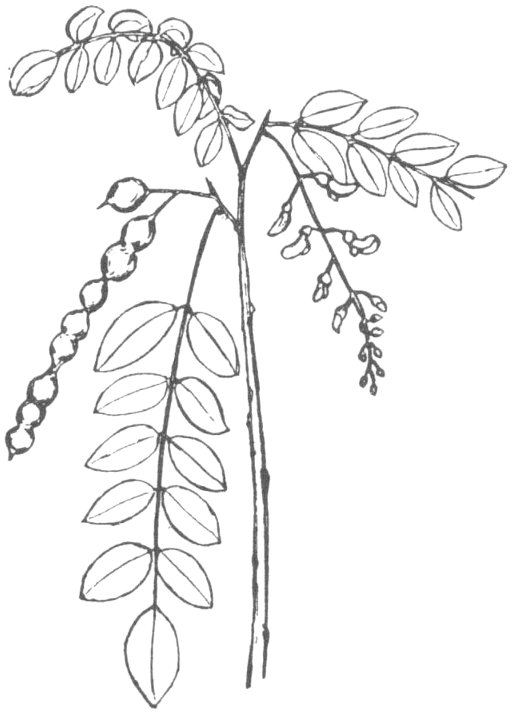
244 Eve’s necklace
245. RIVER LOCUST (Amorpha fruticosa L.) or false indigo: a tall shrub fairly common in low, moist ground, more common in sun than shade. Leaves: pinnately compound, of 9 to 25 leaflets, oblong or elliptical, ½ to 1½ in. long, gland-dotted. Flowers: in dense, erect clusters, each floret consisting of one dark purple petal wrapped around the ten gold-tipped stamens and the style. Fruit: pods about ¼ in. long heavily dotted with amber-colored glands. K (p. 160.)
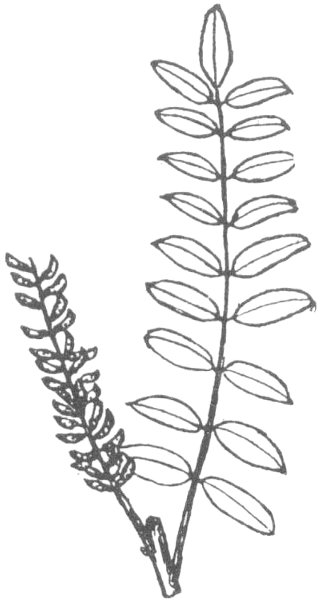
245 river locust
(Citrus Fruits In This Family)
246. PRICKLY ASH (Xanthoxylum clava-herculis L.) also called tear-blanket or toothache tree: a rather small tree common in rich lowlands, “of its largest size on the rich intervale lands of the streams flowing into the Trinity River”. Leaves: pinnately compound of 3 to 9 pairs of leaflets, usually ovate with acute or acuminate tips, 1 to 2½ in. long, shiny above, dull beneath, margins crenate-serrate, aromatic and tingling-spicy as are the fruit and bark. Twigs: have scattered, hooked spines, often black on young shoots. Bark: smooth, bluish gray, conspicuous for its corky, cone-shaped knobs which are sometimes still tipped with sharp spines; bark of root is especially stimulating and tonic, used by negroes for toothache and rheumatism. Flowers: small, white or greenish, in small cymes, opening after the leaves. Fruit: ¼ inch long, and nearly round, pitted capsules split in early autumn to reveal the shiny black seeds; relished 33 by many birds. Wood: light weight, close-grained, light brown with yellow sapwood, not valued as much as the bark.
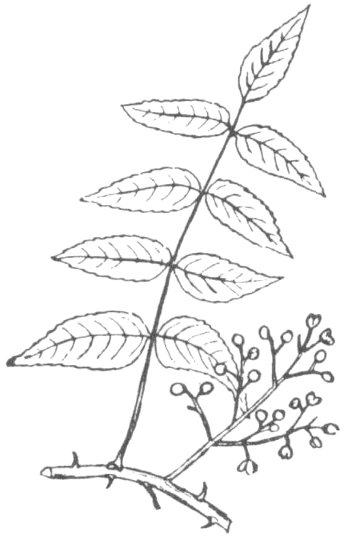
246 prickly ash
247. WAFER ASH (Ptelea trifoliata L.) or hop tree: a rare, small tree or shrub of low woodlands. Leaves: pinnately compound, usually composed of three, rarely five leaflets, 2 to 5 inches long, 1 to 3 wide, the terminal generally larger and more tapering toward the base than the others, margins entire or finely serrate, dark and shiny above, gland-dotted beneath. Twigs: dark, glossy, resembling cherry; winter buds rounded, whitish. Bark: of branches resembles cherry, dark and shining but cracks and curls, becoming rough; bitter, tonic. Flowers: greenish white, compound terminal cymes; in midsummer; disagreeable odor. Fruit: winged seed disks similar to those of elm but larger, nearly 1 inch; the drooping clusters conspicuous on winter branches; occasionally used in place of hops in beer brewing. Wood: heavy, hard and close-grained.
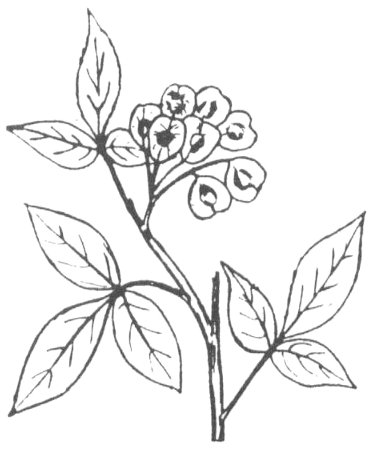
247 wafer ash
248. CHINABERRY (Melia azederach L.) a familiar cultivated tree occasionally escaped from cultivation; a native of China much planted for shade in the southern states; sometimes found in remote woods where birds must have dropped the seeds. Leaves: alternate, twice-pinnately compound, dark green above, margins of leaflets often shallowly lobed or wavy. Twigs: thick, upright, dark. Bark: dark, somewhat smooth on branches. Flowers: lavender, in large, loose clusters on wood of the previous year, scented, in April or May. Fruit: Opaque, yellow, size of marbles, remaining into winter. Wood: light and brittle, color resembles mahogany but the grain is much coarser and does not polish well. I (p. 353.)
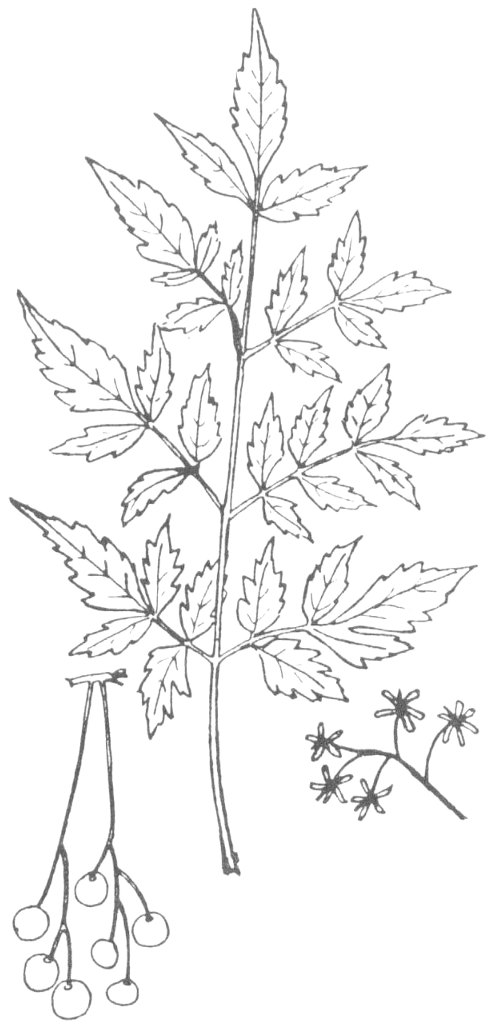
248 chinaberry
248A. TREE OF HEAVEN, Chinese sumac, (Ailanthus glandulosa Desf.) Several sprouts of this tree were observed in Kessler Park woodlands after this booklet had been set in type. The 1 to 3 foot, pinnately compound LEAVES and very stout TWIGS are ready marks of identification. Flowers: greenish, in large panicles, the staminate ill-scented. Fruit: winged seeds rusty colored. Wood: soft and weak. An escape from cultivation, undesirable because of its numerous root-suckers.
249. SMOOTH SUMAC (Rhus glabra L.) abundant tall shrub, in woods or fields, prefers lowlands but also common in shallow depressions of uplands. Leaves: pinnately compound, 6 to 12 inches long, leaflets toothed, dark and smooth above; turning bright scarlet in early autumn. Twigs: smooth, reddish brown or with a whitish bloom; stout; buds entirely encircled by leaf stem or scar, juice milky. Flowers: dioecious, staminate in large, loose clusters of small, creamy flowers; pistillate clusters more compact and soon showing tinge of red. Fruit: dark red, fuzzy, acid skins cover each dry seed, retain color nearly all winter; may be used to make a substitute for lemonade. Wood: too scanty to be of value, center pithy.
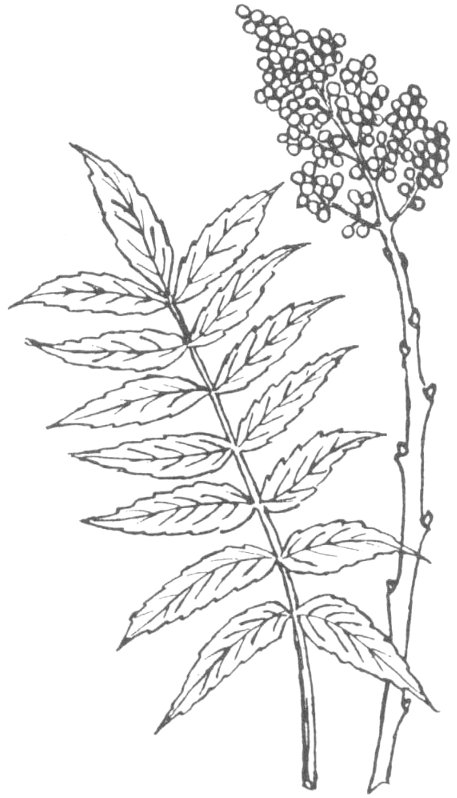
249 smooth sumac
250. WINGED OR DWARF SUMAC (Rhus copallina L.) a tall shrub or rarely a small tree, abundant on limestone hills and bluffs. Leaves: pinnately compound, 6 to 8 inches long, leaflets not or remotely serrate on margins, leafy wings along stem between leaflets. Twigs: slightly pubescent (fuzzy), buds not entirely encircled by leaf scar, juice watery. Flowers: similar to R. glabra but later, in August. Fruit: clusters do not retain their bright color as late. Wood: light and soft, greenish brown.
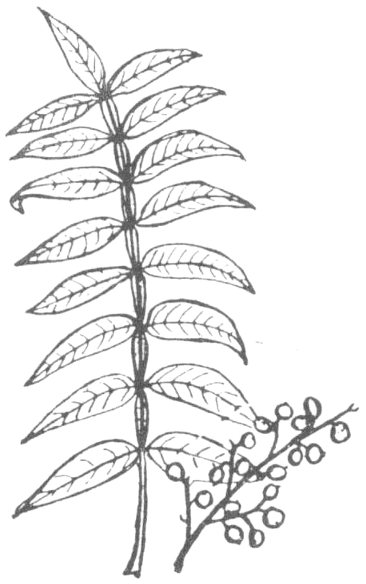
250 winged sumac
251. POISON IVY, POISON OAK (Rhus toxicodendron L.) an abundant, woody, high-climbing vine, often appearing shrubby when young, or in the absence of a support; preferring woodlands, but also in open places. Leaves: compound, of three leaflets 2 to 5 inches long, coarsely toothed or lobed or more rarely entire. Bark: noticeable for numerous aerial rootlets on large specimens. Branches: extending at right angles from main stem. Flowers: inconspicuous, whitish. Fruit: white, in small, loose clusters. All parts of the plant very poisonous to the touch: the apparent immunity of some persons may be lost at any time and those who have suffered previous attacks seem more subject to the poison thereafter.
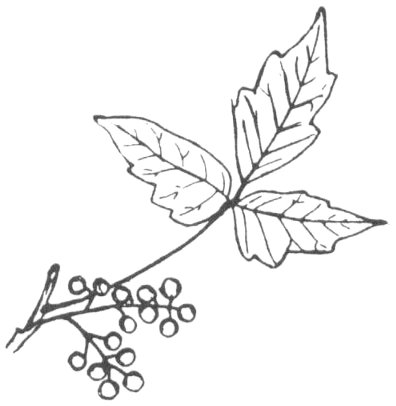
251 poison ivy
252. AROMATIC OR ILL-SCENTED SUMAC (Rhus trilobata and var. aromatica) or skunk bush: a spreading, low to medium shrub common in dry upland woods. Leaves: compound, of three leaflets, teeth or lobes usually rounded, ½ to 1½ inches long; both plants and opinions vary as to whether leaves are aromatic or ill-scented when crushed. Twigs: are noticeable in winter for their cone-shaped buds. Flowers: in March, small, yellow. Fruit: small clusters of red stone fruits covered with white hairs, ripe in midsummer, decorative. K (p. 204-5.)
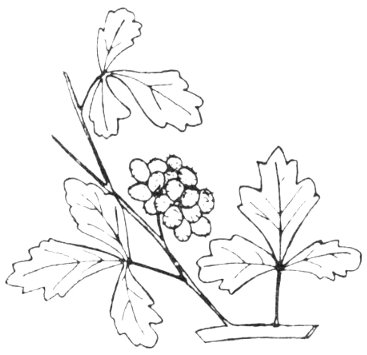
252 aromatic sumac
253. SWAMP HOLLY (Ilex decidua Walt.) or possum haw, a common small tree or shrub thriving best in lowlands, but also grows on dry limestone bluffs. Leaves: 1 to 2 inches long, usually blunt at the tip, margins with small, rounded teeth. Twigs: light gray, the short stems often densely covered with fruit scars, resembling tiny cones; alternate on the branches. Bark: pale gray often mottled, smooth. Flowers: dioecious, white, very inconspicuous. Fruit: round, scarlet or orange, close to the branches, singly or few together, on wood of the previous year, often remain through winter. Wood: heavy, close-grained, creamy-white. This tree suffers from vandals, especially near Christmas, although not evergreen like its spiny-leaved relative, Ilex opaca which is grown commercially and is also a native of East Texas. Youpon (Ilex vomitoria) is another native of East Texas which resembles our swamp holly even more closely except that its leaves are evergreen, and its fruit more pulpy.
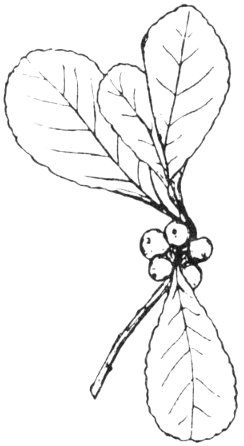
253 swamp holly
254. WAAHOO or burning bush (Evonymus atropurpureus Jacq.) a medium to tall shrub or small tree of low woodlands, not very common. Leaves: opposite, simple, 2 to 5 inches long, tapering at both ends, finely serrate, light green and often turning pinkish in autumn. Twigs: green with gray stripes, often more or less 4-angled. Bark: smoothish, mottled gray. Flowers: small, very dark red, 4-lobed, in May. Fruit: crimson, not more than one in each lobe of 4-lobed rosy pod hanging from red, threadlike stem, in winter. Wood: heavy, hard and close-grained. The climbing bittersweet, native of Oklahoma and East Texas, is a member of this family.
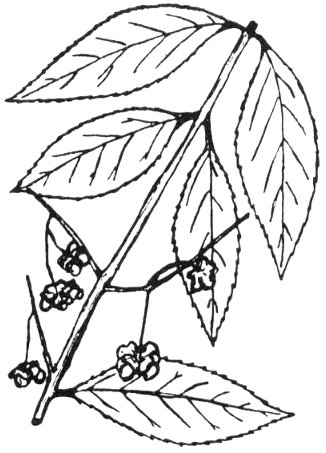
254 waahoo
255. BOX ELDER (Acer negundo L.) a medium-sized tree fairly common in low woods and along stream banks. This is the only member of the family native to Dallas County. Leaves: pinnately compound, opposite, usually 5 leaflets, sometimes 3 or 7, 2½ to 5 in. long, light green, coarsely toothed. Twigs: usually green, smooth. Bark: gray, with regular, shallow furrows. Flowers: dioecious, very small, staminate forming green, silky tassels. Fruit: seeds with elongated wings, in pairs forming v’s, ripen and fall in autumn although their stems cling until spring. Wood: light, soft, close-grained; used for woodenware, interior finish and paper pulp. Sugar can be made from the sap. This tree grows rapidly in a moist situation but is short-lived.
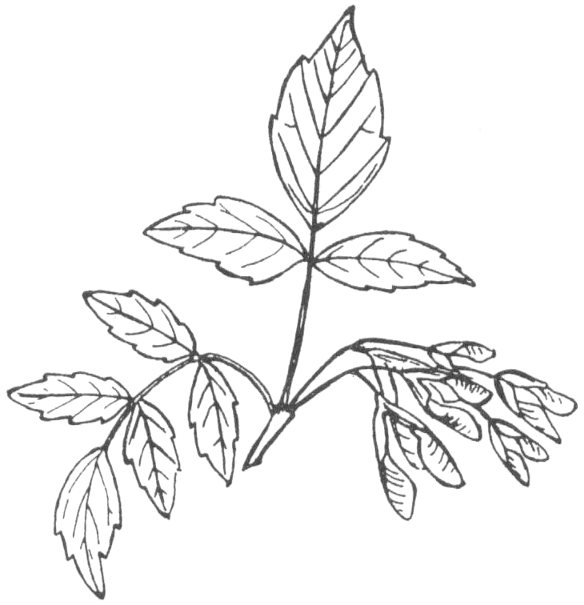
255 box elder
256. SPANISH or TEXAS BUCKEYE (Ungnadia speciosa Endl.) a tall shrub or small tree, not very common, in upland woods; native only to Texas, New Mexico and northern Mexico; Dallas County about its northeastern limit. Leaves: pinnately compound, ash-like but alternate, leaflets 1 to 3 inches long, wrinkled undersurface. Twigs: light brown. Bark: light gray, thin, with numerous shallow fissures. Flowers: color of redbud, slightly larger and averaging two weeks later, 4 or 5 slender petals and red stamens often curving in opposite directions. Fruit: 3 or rarely 4 round, black, shiny seeds, smaller than true buckeyes but having the pale “eye-spot”; leathery brown pods usually crack open and drop the seeds in October or November, themselves remaining through the winter. The seeds are powerful emetics and reputed to be poisonous. Wood: heavy, close-grained, soft but brittle, reddish brown. K (p. 215.)
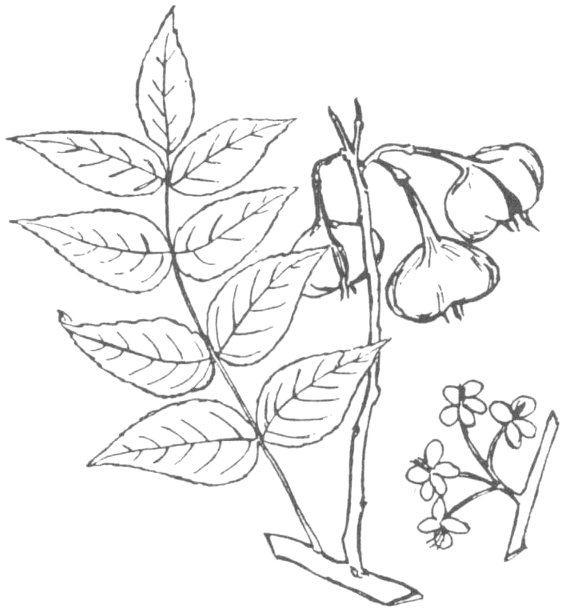
256 Texas buckeye
257. SOAPBERRY or wild chinaberry (Sapindus drummondii H. & A.) a medium-sized tree, fairly common in lowlands, a tree of the southwest-central states. Leaves: pinnately compound of 4 to 9 pairs of sickle-shaped leaflets about 2½ inches long with entire margins; lack the odd terminal leaflet of walnuts and pecans. Twigs: slender, the outer branches often drooping. Bark: light gray, rough and loosely scaly. Flowers: small, creamy white, showy because of large size of the terminal clusters, in May or June. Fruit: golden, or amber, translucent, size of marbles, drooping from tips of branches, remain until spring when they sometimes turn black. Wood: heavy, strong and splits easily between annual rings, hence used for basket splints.
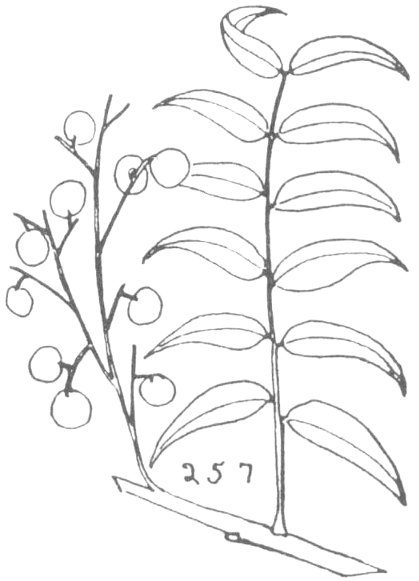
257 soapberry
258. FETID or OHIO BUCKEYE (Aesculus glabra Willd.) medium shrub or rarely small tree in this region, low or upland woods but nowhere common. Leaves: opposite, palmately compound, of 7 to 9 slender, toothed leaflets, 2½ to 4½ inches long, 1 to 2 wide, conspicuous in early spring as they are among the first to open. Twigs: stout, with large opposite buds, the terminal one containing leaves as well as flower clusters; branches usually divide into twos. Flowers: in April, pale yellow clusters, stamens slightly longer than the petals. Fruit: brown, glossy seeds, flattened on one side, with a large, pale “eye-spot”; two or three in a leathery, rounded husk, 1 to 2 inches across, covered with short, scattered prickles. The seed was once believed to be a cure for rheumatism when carried in the pocket. Wood: light, close-grained, tough; used for artificial limbs, splints, woodenware and paper pulp; ill-scented.
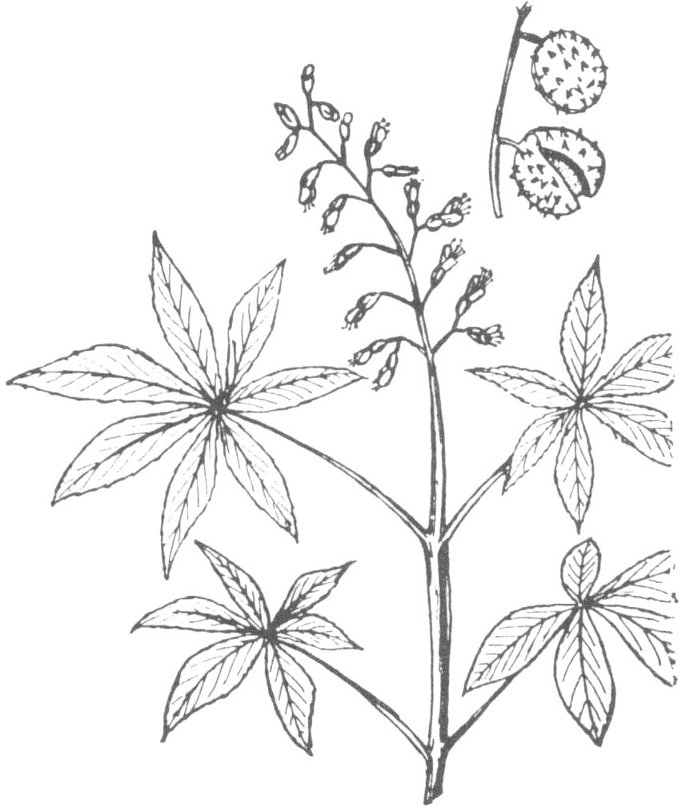
258 Ohio buckeye
259. INDIAN CHERRY (Rhamnus caroliniana Walt.) or yellow buckthorn, a shrub or small tree, fairly common in rich, low woods and limestone slopes. Leaves: glossy, dark green, 2 to 5 in. long and 1 to 2 in. wide, rounded at base and acute or acuminate at tip, margins obscurely serrate, veins yellow, evenly spaced and prominent on the under side; turning dark purple or yellow in autumn, tardily deciduous on young trees. Twigs: with naked winter buds small and pointed. Flowers: in May, inconspicuous, usually dioecious. Fruit: size of small peas, containing 2 to 4 seeds; scattered, on short stems; red in summer, turning black in autumn. Wood: hard, light brown, close-grained and brittle.
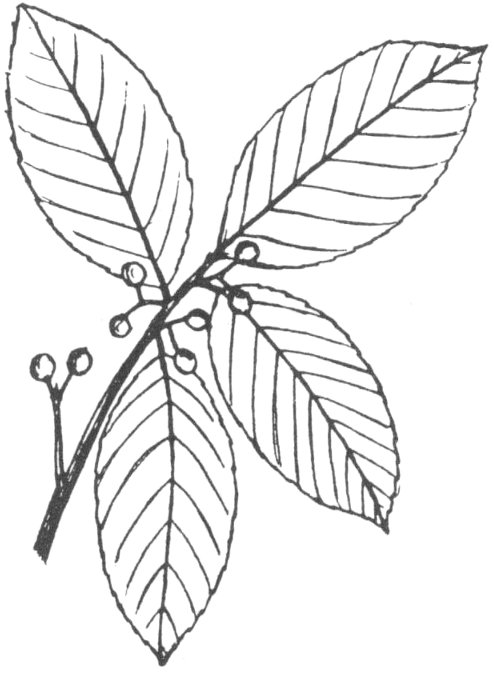
259 Indian cherry
260. NEW JERSEY TEA (Ceanothus ovatus Desf.) or RED-ROOT; a shrub 1 to 3 feet high, common on dry uplands of woods, meadows and roadsides. Leaves: veins depressed above and prominent beneath as in the other two local members of this family, lowest pair longest, not dark and glossy above, 1 or 2 in. long, less than half as wide. Twigs: slender, retaining stems and whitish fruit “cups” in winter. Flowers: tiny, white, fragrant, in small, dense, rather cone-shaped clusters; the 5 petals and 5 sepals all white and incurved, petals forming a hood from which anthers project; in April. Fruit: small, three-lobed, white, ripening in summer. K (p. 216.)
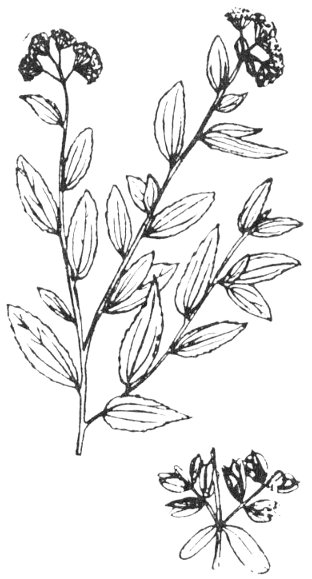
260 New Jersey tea; fruit
261. RATTAN VINE or SUPPLE-JACK (Berchemia scandens Trel.) a fairly common, high-climbing, woody vine of low woods. Leaves: similar to Indian cherry except much smaller, 1 to 2 in. long. Stems: smooth, greenish, pliable, tough, very slender when young, becoming several inches thick in old age. Flowers: small, greenish-white, in small panicles. Fruit: oval, blackish, about ¼ in. long, containing one seed. B (Vol. II, p. 502).
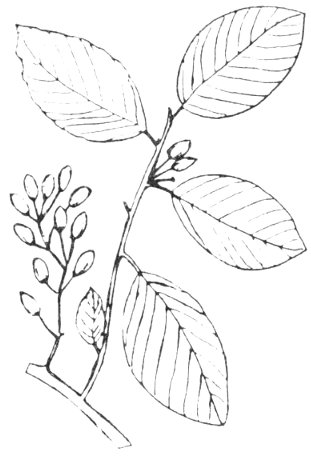
261 rattan vine
262. VIRGINIA CREEPER (Psedera quinquefolia Greene) (Parthenocissus q. Planch.) or woodbine: common woodland vine preferring lowlands, climbing tall trees or covering stumps. Leaves: alternate, palmately compound, of 5 to 7 leaflets, irregularly toothed, tapering at each end, 2 to 4 in. long; turning bright scarlet in early fall. Flowers: clustered, inconspicuous. Fruit: bluish, round, like tiny grapes, popular with birds. More than one species but not readily distinguished. Some have adhesive disks at the tips of tendrils. Often but needlessly confused with poison ivy.
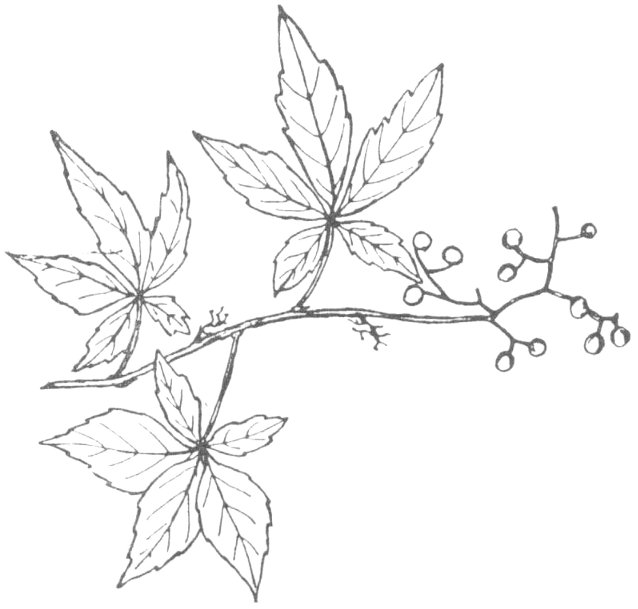
262 Virginia creeper
263. PEPPER VINE (Cissus arborea Des Moulins) a fairly common vine in river bottoms and low, sandy soils. Leaves: alternate, twice-pinnately compound, dark green, reddish when young and in autumn; resembling chinaberry; decorative. Stems: slender. Flowers: whitish, small. Fruit: like small grapes but glossy black, inedible, ripe in August. K (p. 223).
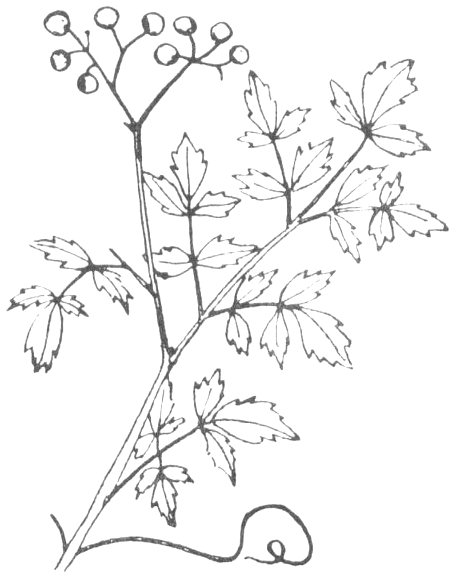
263 pepper vine
264. COW-ITCH VINE (Cissus incisa Des Moulins) a rather rare vine preferring open, sandy woods. Leaves: fleshy, sometimes palmately compound, or deeply 3-lobed or 3-parted. Stems: somewhat fleshy. Flowers: small, in compound umbels, usually 4 spreading petals. Fruit: small, grape-like, blackish. K (p. 222).
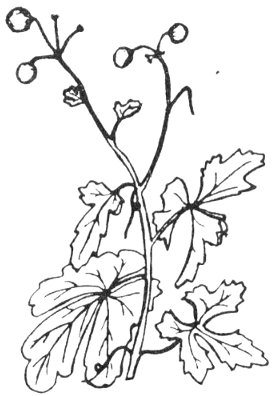
264 cow-itch vine
265. (CISSUS AMPELOPSIS Pers.) no common name; a rare vine of low woods. Leaves: grape-like, but smooth and thin, broadly oval, or heart-shaped, coarsely toothed. Fruit: bluish, inedible, like small grapes. Main STEM: sometimes with many short, leafy branches. B (Vol. II, p. 509).
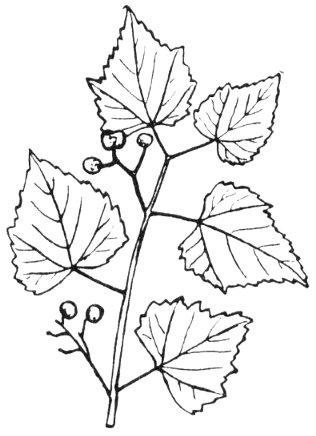
265 Cissus ampelopsis
266. MUSTANG GRAPE (Vitis candicans Engelm.) abundant vine of roadside thickets and woods. Leaves: large, angled, shallow-toothed, very wooly beneath; the leaves of young shoots are usually deeply, many-lobed in marked contrast to the older. Flowers: small, whitish, fragrant, in drooping clusters. Fruit: large as marbles, acid, but palatable, blackish, ripe July. K (p. 220).
267. SUMMER GRAPE (Vitis species) a vine of woods and roadside thickets. Leaves: large, unlobed to deeply lobed, wooly when young. Fruit: small, pleasant, ripe in autumn.
268. ST. ANDREW’S CROSS (Ascyrum hypericoides L.) low shrub of low, sandy woods, rather rare. Leaves: ½ to 1½ inches long, opposite, many remaining green through mild winters. Flowers: yellow, about ½ inch across, of four petals, falling early; two of four sepals larger, leaflike, clasping bud or seed-pod between them. Fruit: several small seeds in each disk-like pod, tardily deciduous. B (Vol. II, p. 528).
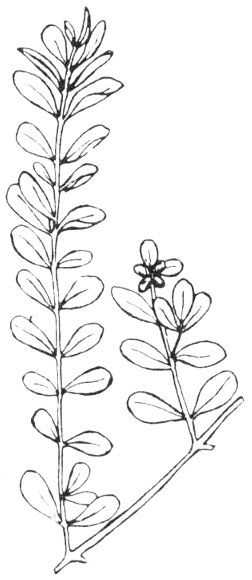
268 St. Andrew’s cross
269. PRICKLY PEAR CACTUS (Opuntia Sp.) a shrub, common in meadows and dry woods. Branches (joints): broad, flat, green, spiny and somewhat leaflike. True LEAVES: small, fleshy, thick scales, early deciduous. Flowers: 2 to 5 inches across, having many glossy, yellow petals and numerous stamens. Fruit: reddish, prickly, about an inch across and slightly longer. This shrub is a valued forage crop in many parts of western Texas, after the spines have been burned off with a blow torch.
270. FLOWERING DOGWOOD (Cornus florida L.) shrub or small tree, very rare; usually in rocky or sandy woods, often with cedar. Leaves: simple, 2 to 5 inches long, 1¼ to 2 wide, opposite, mostly in clusters at the ends of branches; entire or nearly so, veins prominent beneath. Twigs: distinguished in winter by the pale “flat turnip-shaped” flower buds; bright red or yellowish green, slender. Bark: furrowed and breaking into somewhat rectangular plates; astringent and aromatic, used in medicine. Branches: usually horizontally spreading and upcurved at tips. Flowers: greenish yellow, small, in dense heads surrounded by 4 large, white, notched, petal-like bracts; in March and April. Fruit: dense clusters of glossy, scarlet, oval berries, about ½ inch long. Wood: heavy, hard, strong, very close-grained; for turnery, tool handles, forms for metal-spinners for which last it is sold by the pound.
271. DWARF or ROUGH-LEAF DOGWOOD (Cornus asperifolia Michx.) a large shrub, or rarely a small tree, common and widespread, preferring lowlands. Leaves: simple, opposite, nearly entire, rough above, paler and downy beneath, 2 to 4 inches long, ovate or oblong. Twigs: bright red in winter, rough or with whitish pubescence. Bark: thin, narrowly ridged, with close, dark red-brown scales. Flowers: small, white, in flat-topped clusters, in April or May following black haw flowers which they resemble. Fruit: small, white, on reddish stems, ripe late summer and fall. Wood: heavy, hard, strong, fine-grained; adapted for turnery.
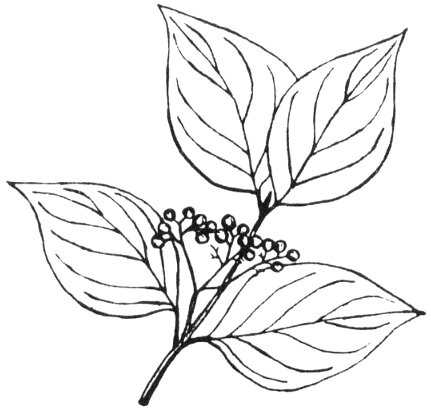
271 dwarf dogwood
272. WOOLY BUMELIA, CHITTAM WOOD, or GUM ELASTIC (Bumelia lanuginosa Pers.) a common tree of widespread and varied habitat. Leaves: mostly blunt at apex, entire, 1 to 2½ inches long, dark and smooth above, whitish or sometimes rusty, wooly beneath, especially when young; tardily deciduous. Twigs: with small, scattered spines usually tipping the smallest twigs. Flowers: in July, whitish, inconspicuous. Fruit: ripe Sept. and Oct., oval, black, few or solitary; sweetish, with a single, dark brown, shining seed about ¼ inch across. Wood: hard, heavy, tough, smooth-grained.
273. PERSIMMON (Diospyros virginiana L.) a common small or rarely large tree, on dry, open ground, old fields or sometimes rich bottom lands. Leaves: ovate, entire, 4 to 6 inches long, dark and shining above, paler beneath. Twigs: slender, light brown or ashy gray, with a thick pith cavity. Bark: dark, divided into nearly square blocks. Flowers: dioecious, pistillate solitary bell-shaped about ¾ inch deep and ½ inch wide; staminate shorter and tubular clustered in 2’s or 3’s; both creamy colored, opening in May. Fruit: soft, round, orange-brown, about 1 to 2 inches across, containing many large, flat, smooth seeds; edible, ripe in fall and winter, whenever the calyx separates readily from the fruit. Wood: hard, dense, strong; brown or black heartwood, wide sapwood white or yellowish; used for shuttles, golf-stick heads, but not commercially valuable.
274. WHITE ASH (Fraxinus americana L.) a common, rather large tree of widespread and various habitat. Leaves: opposite, pinnately compound, 5 to 9 but usually 7 leaflets, entire or with obscure or rounded teeth, 3 to 5 inches long and 1½ to 3 wide, dark green above and paler beneath. Twigs: stout, gray or light brown in winter, with large, roundish leaf-scars concave or notched on upper side. Bark: dark brown or gray, broken by many narrow fissures. Flowers: dioecious, the staminate clusters often mistaken for seeds when they harden and cling through winter, a condition caused by the sting of an insect mite. Fruit: nearly cylindrical seed with a 41 thin wing attached, oar-shaped, 1 to 2½ inches long, in dense clusters. Wood: heavy, hard, tough, strong, brown; valuable for tool handles, oars, furniture and interiors; valued as a shade tree.
275. GREEN ASH (Fraxinus pennsylvanica var. lanceolata Sarge.) prefers bottom lands. Leaves: differ from white ash in the leaf color which is light or bright green on both sides, margins more sharply serrate and serrations extending nearly to the base, leaflets narrower. Fruit: wings extend more than half way along two sides of the seed portion. Twigs: leaf-scar straight or nearly so on upper side. Since this tree often hybridizes with the white ash, the species are sometimes hard to distinguish.
276. SPRING HERALD (Adelia pubescens Nutt.) spring goldenglow, or devil’s elbow; an abundant shrub of medium height, widespread but preferring upland woods. Leaves: simple, opposite, ¾ to 1½ inches long, blunt, with fine, rounded teeth. Twigs: light, gray, zigzag or tangled. Flowers: dioecious, very early, petal-less, clusters of stamens pale yellow, pistillate flowers greenish. Fruit: oval, bluish, ripen and fall early in summer. These bushes make dense cover for birds and small animals. It is always distinguishable from swamp holly by its opposite twigs. K (p. 287).
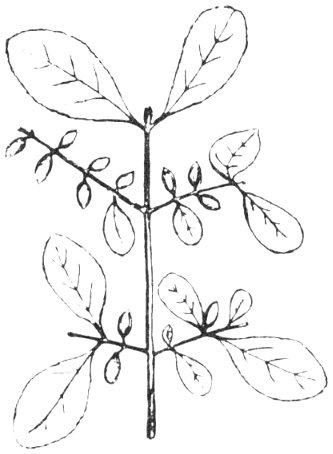
276 spring herald
277. SWAMP PRIVET (Adelia acuminata Poir.) a tall shrub or rarely a small tree growing only in low or swampy woods where fairly common. Leaves: opposite, usually 1½ to 3 inches long and about an inch wide, margins entire or finely serrate, tips acuminate. Twigs and BARK: dark, rather smooth with light dots. Flowers: similar to spring herald. Fruit: elongated, usually tapering.
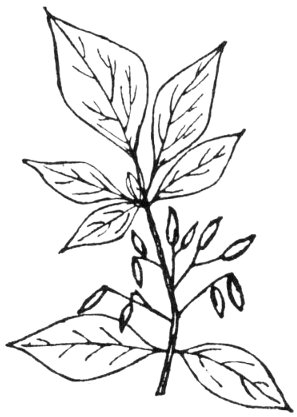
277 swamp privet
278. FRENCH MULBERRY (Callicarpa americana L.) or beautyberry: a medium shrub fairly common in low woods especially where sandy. Leaves: simple, opposite, coarsely toothed, 3 to 5 inches long, 1½ to 3 wide, light green, tapering at both ends, softly fuzzy on both sides and with tiny shining glands beneath. Twigs: with pale, rusty fuzz. Flowers: pale pink, in dense clusters close to the branches at each pair of leaves. Fruit: bright reddish purple, about ¼ inch across, in dense clusters 1 to 1½ inches across, surrounding the stems. Often planted for the decorative fruits which are attractive to birds. K (p. 341).
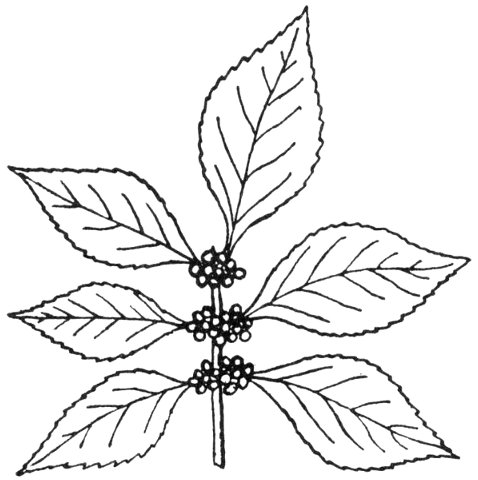
278 French mulberry
279. CIGAR TREE (Catalpa speciosa Warder.) a tree well known in cultivation and rarely as an escape, in woods. This tree with its large, opposite, heart-shaped LEAVES, showy white or lavender, flaring bell-shaped FLOWERS and pencil-like PODS is too conspicuous to require a detailed description. Wood: soft, light, coarse-grained; sometimes planted in groves in rich soil for use as fence posts or sometimes for railroad ties.
280. TRUMPET CREEPER (Tecoma radicans L.) a rare vine growing along fence rows and edges of woods in sandy land; common in East Texas. Leaves: pinnately compound and opposite, of 9 to 11 leaflets, toothed, pointed, ovate. Flowers: large, orange-red, flaring trumpet-shaped, nearly 3 inches long. Fruit: pods 2 to 5 inches long, tapered; seeds flat, winged, numerous.
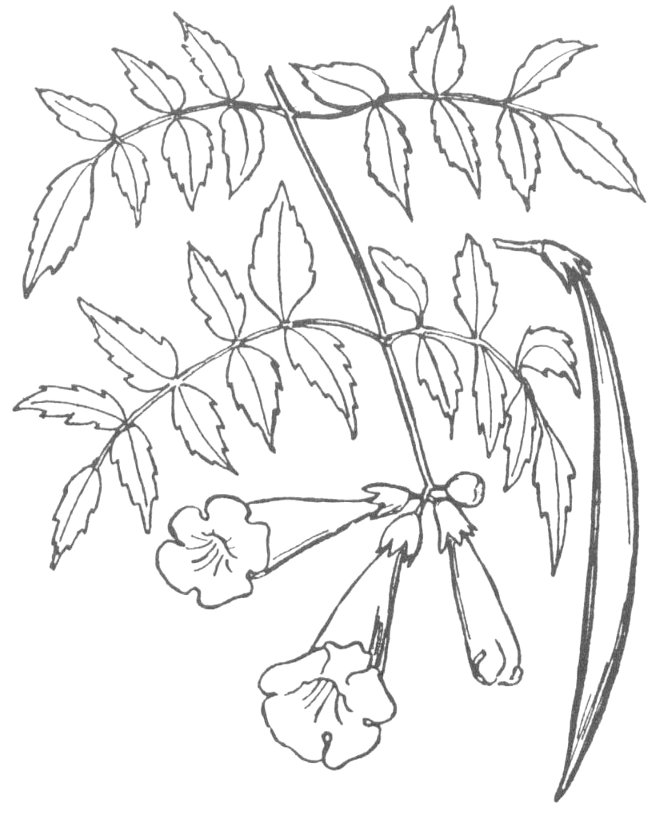
280 trumpet creeper
281. BUTTONBUSH (Cephalanthus occidentalis L.) button willow: usually a large shrub, fairly common in swamps or near water; often cultivated. Leaves: simple, opposite or in whorls of 3 or more, smooth, dark green, with a stout yellow midrib, 2 to 7 inches long, ½ to 3½ wide. Twigs: stout, smooth, with a thick pith, pale reddish-brown and covered with a bloom in their first winter. Bark: dark, rough, with narrow scales; contains tannin; used in treatment of fevers. Flowers: creamy white, fragrant, in dense balls about 1 to 1½ inches in diameter. Fruit: a dark brownish, hard ball, remaining through the winter.
282. CORAL HONEYSUCKLE or TRUMPET HONEYSUCKLE (Lonicera sempervirens L.) an evergreen vine, rare except in cultivation; common in East Texas; low woods and thickets. Leaves: oblong, smooth, upper pairs united or encircling stem. Flowers: Trumpet-shaped, light red, yellowish inside, 1 to 1½ inches long, in clusters. Fruit: scarlet, fleshy.
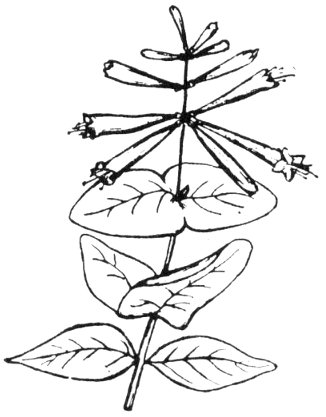
282 coral honeysuckle
283. BUSH HONEYSUCKLE (Lonicera albiflora T. & G.) not very common; on limestone bluffs, upland meadows and thickets. Leaves: opposite, upper pair usually united or encircling stem, not evergreen. Stems: stiff and upright or sometimes long and trailing, both usually to be found on one bush; this habit is the best point of distinction between this species and the rarer trumpet honeysuckle when there are no flowers present. Fruit: scarlet, fleshy. Flowers: whitish or yellowish, small. K (p. 382).
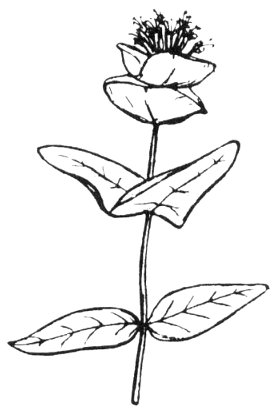
283 bush honeysuckle
284. INDIAN CURRANT (Symphoricarpos orbiculatus Moench.) or coralberry, the last name also used for other plants, locally well known as buckbrush or partridge brush. This 1 to 3-foot shrub is abundant in woodlands, especially in rich soil. Leaves: simple, opposite, entire or nearly, 1 to 1½ inches long, usually blunt at tip, darker above. Twigs: wiry, brown. Flowers: white, small, in dense clusters at leaf-axils. Fruit: magenta red, in dense clusters encircling stems, remaining through winter. The much smaller size of bush, leaves and fruit clusters prevents confusion with French mulberry. B (Vol. III, p. 277).
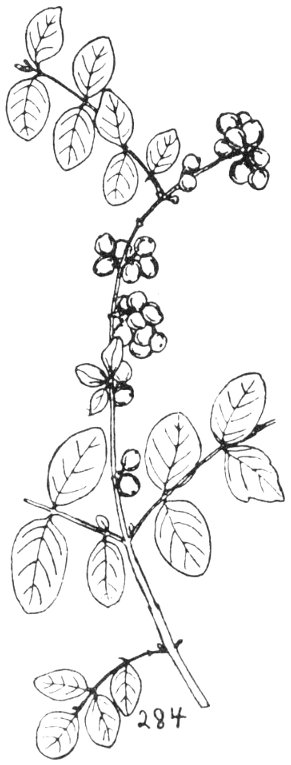
284 Indian current
285. BLACK HAW (Viburnum rufidulum Raf.) or possum haw: a shrub or more often a small tree; in woods, preferring lowlands. Leaves: thick, glossy, finely serrate, about 3 inches long and half as wide; a rusty fuzz at the base of the veins beneath; simple, opposite, red in autumn. Twigs: sometimes coated with rusty fuzz as the buds always are. Bark: dark reddish brown, with small, roundish scales. Flowers: late March or early April, white, in flat clusters about 5 or 6 inches across. Fruit: oval, about one-half inch long, blue with a bloom, containing a single stony seed; especially attractive in autumn, turning from red to blue. Wood: ill-scented.
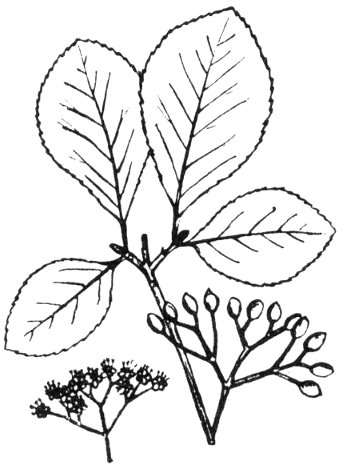
285 black haw
286. ELDERBERRY or common elder (Sambucus canadensis L.) usually a tall shrub; common in low, rich woods. Leaves: pinnately compound, of 5 to 11 oblong, or oval, smooth leaflets, 2 to 4 inches long, the lower often 3-parted; sharply serrate, opposite. Twigs: with thin woody layer surrounding thick white pith. Flowers: small, white, in large, compound, flat clusters; sweet-scented. Fruit: purplish black, glossy, juicy, popular with birds, ripe in late summer. K (p. 381).
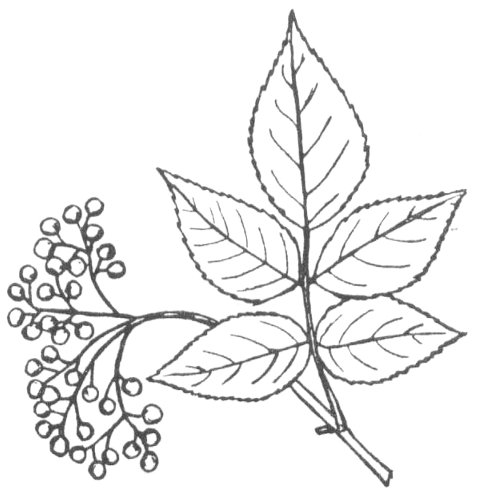
286 elderberry
A. Blakeslee & Jarvis, “Trees in Winter,” Macmillan, 1926. Includes only the trees found in New England, about 25 of them also here; illustrated. Contains a good section on the care and planting of trees.
B. Britton & Brown, “Illustrated Flora of the Northern States and Canada,” 3 vol., Charles Scribner’s Sons, 1913 edition. These volumes, though technical, are helpful in the identification of many plants because of the detailed line drawings which illustrate every species.
C. Brown, H. P., “Trees of Northeastern United States,” Christopher Publishing house, 1938, second edition. Useful leaf, fruit and twig keys.
D. Coulter, John M., “Botany of Western Texas,” the U. S. National Herbarium, Vol. II, U. S. Dept. of Agriculture, Washington, D. C., 1894. Obviously out of date and also out of print but describes a few species of this region which are to be found in no other book.
E. Gray, Asa, “Gray’s New Manual of Botany,” American Book Co., 7th edition, 1908. A technical handbook for the flowering plants and ferns of the Central and Northeastern states and Canada. Mentioned here because its system of classification and scientific names has been followed, in most cases. This manual more nearly conforms to the new international rules of classification than any other available, except Sargent.
F. Hough, Romeyn Beck, “Handbook of the Trees of the Northern States and Canada.” Published by the author, Lowville, N. Y., 1907. Includes many of our trees and useful because of the detailed photographic illustrations.
G. Mattoon & Webster, “Forest Trees of Texas,” bulletin 20, Texas Forest Service, College Station, 1928. Contains descriptions and drawings of 92 Texas trees, about 45 of them in Dallas County. Inexpensive.
H. Parks, H. B., “Valuable Plants Native to Texas,” Bulletin 551, Texas Agricultural Experiment Station, College Station, 1937. Notes on the uses and habits of native plants, with special emphasis on honey plants.
I. Rogers, Julia Ellen, “The Tree Book,” Doubleday Page, 1912. Old but still popular guide to the trees of North America, illustrated. Useful and interesting facts about trees are here told in a most interesting manner.
J. Sargent, Charles Sprague, “Manual of the Trees of North America,” Houghton Mifflin, 1933. Includes complete technical descriptions of the 56 plants in this booklet which sometimes attain such height and habit as to be called trees.
K. Schulz, Ellen D. (Quillen), “Texas Wild Flowers,” Laidlaw Bros., 1928. Describes about 18 of the species in this booklet. One of the best books for beginners in the study of wild flowers of our region.
L. Small, John Kunkel, “Flora of the Southeastern United States,” published by the author, 1903. This is the only complete floral manual ever published which includes Dallas County. Needed for identification of a few species but the book is out-of-date in its system of classification and also out of print. Ditto for the edition of 1913.
M. Small, John Kunkel, “Manual of the Southeastern Flora,” published by the author, New York, 1933. Descriptions technical but helpful in the identification of a few species not described in many other books. This volume does not include Texas.
A B C D E F G H I J K L M N O P Q R S T U V W X Y Z
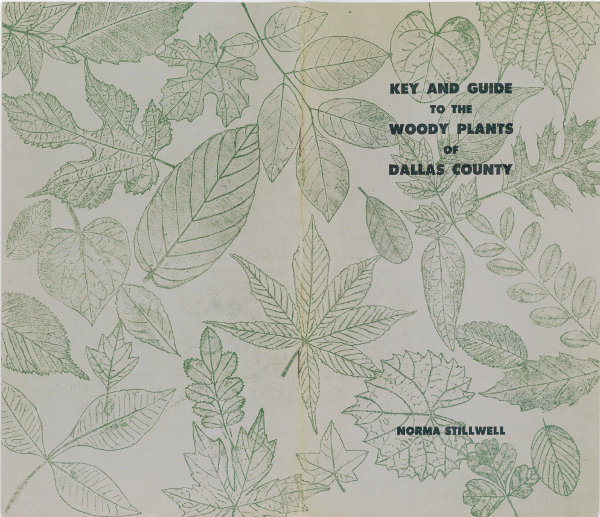
End of the Project Gutenberg EBook of Key and Guide to Native Trees, Shrubs,
and Woody Vines of Dallas County, by Norma J. Stillwell
*** END OF THIS PROJECT GUTENBERG EBOOK NATIVE TREES, SHRUBS, AND WOODY VINES ***
***** This file should be named 58703-h.htm or 58703-h.zip *****
This and all associated files of various formats will be found in:
http://www.gutenberg.org/5/8/7/0/58703/
Produced by Stephen Hutcheson and the Online Distributed
Proofreading Team at http://www.pgdp.net
Updated editions will replace the previous one--the old editions will
be renamed.
Creating the works from print editions not protected by U.S. copyright
law means that no one owns a United States copyright in these works,
so the Foundation (and you!) can copy and distribute it in the United
States without permission and without paying copyright
royalties. Special rules, set forth in the General Terms of Use part
of this license, apply to copying and distributing Project
Gutenberg-tm electronic works to protect the PROJECT GUTENBERG-tm
concept and trademark. Project Gutenberg is a registered trademark,
and may not be used if you charge for the eBooks, unless you receive
specific permission. If you do not charge anything for copies of this
eBook, complying with the rules is very easy. You may use this eBook
for nearly any purpose such as creation of derivative works, reports,
performances and research. They may be modified and printed and given
away--you may do practically ANYTHING in the United States with eBooks
not protected by U.S. copyright law. Redistribution is subject to the
trademark license, especially commercial redistribution.
START: FULL LICENSE
THE FULL PROJECT GUTENBERG LICENSE
PLEASE READ THIS BEFORE YOU DISTRIBUTE OR USE THIS WORK
To protect the Project Gutenberg-tm mission of promoting the free
distribution of electronic works, by using or distributing this work
(or any other work associated in any way with the phrase "Project
Gutenberg"), you agree to comply with all the terms of the Full
Project Gutenberg-tm License available with this file or online at
www.gutenberg.org/license.
Section 1. General Terms of Use and Redistributing Project
Gutenberg-tm electronic works
1.A. By reading or using any part of this Project Gutenberg-tm
electronic work, you indicate that you have read, understand, agree to
and accept all the terms of this license and intellectual property
(trademark/copyright) agreement. If you do not agree to abide by all
the terms of this agreement, you must cease using and return or
destroy all copies of Project Gutenberg-tm electronic works in your
possession. If you paid a fee for obtaining a copy of or access to a
Project Gutenberg-tm electronic work and you do not agree to be bound
by the terms of this agreement, you may obtain a refund from the
person or entity to whom you paid the fee as set forth in paragraph
1.E.8.
1.B. "Project Gutenberg" is a registered trademark. It may only be
used on or associated in any way with an electronic work by people who
agree to be bound by the terms of this agreement. There are a few
things that you can do with most Project Gutenberg-tm electronic works
even without complying with the full terms of this agreement. See
paragraph 1.C below. There are a lot of things you can do with Project
Gutenberg-tm electronic works if you follow the terms of this
agreement and help preserve free future access to Project Gutenberg-tm
electronic works. See paragraph 1.E below.
1.C. The Project Gutenberg Literary Archive Foundation ("the
Foundation" or PGLAF), owns a compilation copyright in the collection
of Project Gutenberg-tm electronic works. Nearly all the individual
works in the collection are in the public domain in the United
States. If an individual work is unprotected by copyright law in the
United States and you are located in the United States, we do not
claim a right to prevent you from copying, distributing, performing,
displaying or creating derivative works based on the work as long as
all references to Project Gutenberg are removed. Of course, we hope
that you will support the Project Gutenberg-tm mission of promoting
free access to electronic works by freely sharing Project Gutenberg-tm
works in compliance with the terms of this agreement for keeping the
Project Gutenberg-tm name associated with the work. You can easily
comply with the terms of this agreement by keeping this work in the
same format with its attached full Project Gutenberg-tm License when
you share it without charge with others.
1.D. The copyright laws of the place where you are located also govern
what you can do with this work. Copyright laws in most countries are
in a constant state of change. If you are outside the United States,
check the laws of your country in addition to the terms of this
agreement before downloading, copying, displaying, performing,
distributing or creating derivative works based on this work or any
other Project Gutenberg-tm work. The Foundation makes no
representations concerning the copyright status of any work in any
country outside the United States.
1.E. Unless you have removed all references to Project Gutenberg:
1.E.1. The following sentence, with active links to, or other
immediate access to, the full Project Gutenberg-tm License must appear
prominently whenever any copy of a Project Gutenberg-tm work (any work
on which the phrase "Project Gutenberg" appears, or with which the
phrase "Project Gutenberg" is associated) is accessed, displayed,
performed, viewed, copied or distributed:
This eBook is for the use of anyone anywhere in the United States and
most other parts of the world at no cost and with almost no
restrictions whatsoever. You may copy it, give it away or re-use it
under the terms of the Project Gutenberg License included with this
eBook or online at www.gutenberg.org. If you are not located in the
United States, you'll have to check the laws of the country where you
are located before using this ebook.
1.E.2. If an individual Project Gutenberg-tm electronic work is
derived from texts not protected by U.S. copyright law (does not
contain a notice indicating that it is posted with permission of the
copyright holder), the work can be copied and distributed to anyone in
the United States without paying any fees or charges. If you are
redistributing or providing access to a work with the phrase "Project
Gutenberg" associated with or appearing on the work, you must comply
either with the requirements of paragraphs 1.E.1 through 1.E.7 or
obtain permission for the use of the work and the Project Gutenberg-tm
trademark as set forth in paragraphs 1.E.8 or 1.E.9.
1.E.3. If an individual Project Gutenberg-tm electronic work is posted
with the permission of the copyright holder, your use and distribution
must comply with both paragraphs 1.E.1 through 1.E.7 and any
additional terms imposed by the copyright holder. Additional terms
will be linked to the Project Gutenberg-tm License for all works
posted with the permission of the copyright holder found at the
beginning of this work.
1.E.4. Do not unlink or detach or remove the full Project Gutenberg-tm
License terms from this work, or any files containing a part of this
work or any other work associated with Project Gutenberg-tm.
1.E.5. Do not copy, display, perform, distribute or redistribute this
electronic work, or any part of this electronic work, without
prominently displaying the sentence set forth in paragraph 1.E.1 with
active links or immediate access to the full terms of the Project
Gutenberg-tm License.
1.E.6. You may convert to and distribute this work in any binary,
compressed, marked up, nonproprietary or proprietary form, including
any word processing or hypertext form. However, if you provide access
to or distribute copies of a Project Gutenberg-tm work in a format
other than "Plain Vanilla ASCII" or other format used in the official
version posted on the official Project Gutenberg-tm web site
(www.gutenberg.org), you must, at no additional cost, fee or expense
to the user, provide a copy, a means of exporting a copy, or a means
of obtaining a copy upon request, of the work in its original "Plain
Vanilla ASCII" or other form. Any alternate format must include the
full Project Gutenberg-tm License as specified in paragraph 1.E.1.
1.E.7. Do not charge a fee for access to, viewing, displaying,
performing, copying or distributing any Project Gutenberg-tm works
unless you comply with paragraph 1.E.8 or 1.E.9.
1.E.8. You may charge a reasonable fee for copies of or providing
access to or distributing Project Gutenberg-tm electronic works
provided that
* You pay a royalty fee of 20% of the gross profits you derive from
the use of Project Gutenberg-tm works calculated using the method
you already use to calculate your applicable taxes. The fee is owed
to the owner of the Project Gutenberg-tm trademark, but he has
agreed to donate royalties under this paragraph to the Project
Gutenberg Literary Archive Foundation. Royalty payments must be paid
within 60 days following each date on which you prepare (or are
legally required to prepare) your periodic tax returns. Royalty
payments should be clearly marked as such and sent to the Project
Gutenberg Literary Archive Foundation at the address specified in
Section 4, "Information about donations to the Project Gutenberg
Literary Archive Foundation."
* You provide a full refund of any money paid by a user who notifies
you in writing (or by e-mail) within 30 days of receipt that s/he
does not agree to the terms of the full Project Gutenberg-tm
License. You must require such a user to return or destroy all
copies of the works possessed in a physical medium and discontinue
all use of and all access to other copies of Project Gutenberg-tm
works.
* You provide, in accordance with paragraph 1.F.3, a full refund of
any money paid for a work or a replacement copy, if a defect in the
electronic work is discovered and reported to you within 90 days of
receipt of the work.
* You comply with all other terms of this agreement for free
distribution of Project Gutenberg-tm works.
1.E.9. If you wish to charge a fee or distribute a Project
Gutenberg-tm electronic work or group of works on different terms than
are set forth in this agreement, you must obtain permission in writing
from both the Project Gutenberg Literary Archive Foundation and The
Project Gutenberg Trademark LLC, the owner of the Project Gutenberg-tm
trademark. Contact the Foundation as set forth in Section 3 below.
1.F.
1.F.1. Project Gutenberg volunteers and employees expend considerable
effort to identify, do copyright research on, transcribe and proofread
works not protected by U.S. copyright law in creating the Project
Gutenberg-tm collection. Despite these efforts, Project Gutenberg-tm
electronic works, and the medium on which they may be stored, may
contain "Defects," such as, but not limited to, incomplete, inaccurate
or corrupt data, transcription errors, a copyright or other
intellectual property infringement, a defective or damaged disk or
other medium, a computer virus, or computer codes that damage or
cannot be read by your equipment.
1.F.2. LIMITED WARRANTY, DISCLAIMER OF DAMAGES - Except for the "Right
of Replacement or Refund" described in paragraph 1.F.3, the Project
Gutenberg Literary Archive Foundation, the owner of the Project
Gutenberg-tm trademark, and any other party distributing a Project
Gutenberg-tm electronic work under this agreement, disclaim all
liability to you for damages, costs and expenses, including legal
fees. YOU AGREE THAT YOU HAVE NO REMEDIES FOR NEGLIGENCE, STRICT
LIABILITY, BREACH OF WARRANTY OR BREACH OF CONTRACT EXCEPT THOSE
PROVIDED IN PARAGRAPH 1.F.3. YOU AGREE THAT THE FOUNDATION, THE
TRADEMARK OWNER, AND ANY DISTRIBUTOR UNDER THIS AGREEMENT WILL NOT BE
LIABLE TO YOU FOR ACTUAL, DIRECT, INDIRECT, CONSEQUENTIAL, PUNITIVE OR
INCIDENTAL DAMAGES EVEN IF YOU GIVE NOTICE OF THE POSSIBILITY OF SUCH
DAMAGE.
1.F.3. LIMITED RIGHT OF REPLACEMENT OR REFUND - If you discover a
defect in this electronic work within 90 days of receiving it, you can
receive a refund of the money (if any) you paid for it by sending a
written explanation to the person you received the work from. If you
received the work on a physical medium, you must return the medium
with your written explanation. The person or entity that provided you
with the defective work may elect to provide a replacement copy in
lieu of a refund. If you received the work electronically, the person
or entity providing it to you may choose to give you a second
opportunity to receive the work electronically in lieu of a refund. If
the second copy is also defective, you may demand a refund in writing
without further opportunities to fix the problem.
1.F.4. Except for the limited right of replacement or refund set forth
in paragraph 1.F.3, this work is provided to you 'AS-IS', WITH NO
OTHER WARRANTIES OF ANY KIND, EXPRESS OR IMPLIED, INCLUDING BUT NOT
LIMITED TO WARRANTIES OF MERCHANTABILITY OR FITNESS FOR ANY PURPOSE.
1.F.5. Some states do not allow disclaimers of certain implied
warranties or the exclusion or limitation of certain types of
damages. If any disclaimer or limitation set forth in this agreement
violates the law of the state applicable to this agreement, the
agreement shall be interpreted to make the maximum disclaimer or
limitation permitted by the applicable state law. The invalidity or
unenforceability of any provision of this agreement shall not void the
remaining provisions.
1.F.6. INDEMNITY - You agree to indemnify and hold the Foundation, the
trademark owner, any agent or employee of the Foundation, anyone
providing copies of Project Gutenberg-tm electronic works in
accordance with this agreement, and any volunteers associated with the
production, promotion and distribution of Project Gutenberg-tm
electronic works, harmless from all liability, costs and expenses,
including legal fees, that arise directly or indirectly from any of
the following which you do or cause to occur: (a) distribution of this
or any Project Gutenberg-tm work, (b) alteration, modification, or
additions or deletions to any Project Gutenberg-tm work, and (c) any
Defect you cause.
Section 2. Information about the Mission of Project Gutenberg-tm
Project Gutenberg-tm is synonymous with the free distribution of
electronic works in formats readable by the widest variety of
computers including obsolete, old, middle-aged and new computers. It
exists because of the efforts of hundreds of volunteers and donations
from people in all walks of life.
Volunteers and financial support to provide volunteers with the
assistance they need are critical to reaching Project Gutenberg-tm's
goals and ensuring that the Project Gutenberg-tm collection will
remain freely available for generations to come. In 2001, the Project
Gutenberg Literary Archive Foundation was created to provide a secure
and permanent future for Project Gutenberg-tm and future
generations. To learn more about the Project Gutenberg Literary
Archive Foundation and how your efforts and donations can help, see
Sections 3 and 4 and the Foundation information page at
www.gutenberg.org Section 3. Information about the Project Gutenberg
Literary Archive Foundation
The Project Gutenberg Literary Archive Foundation is a non profit
501(c)(3) educational corporation organized under the laws of the
state of Mississippi and granted tax exempt status by the Internal
Revenue Service. The Foundation's EIN or federal tax identification
number is 64-6221541. Contributions to the Project Gutenberg Literary
Archive Foundation are tax deductible to the full extent permitted by
U.S. federal laws and your state's laws.
The Foundation's principal office is in Fairbanks, Alaska, with the
mailing address: PO Box 750175, Fairbanks, AK 99775, but its
volunteers and employees are scattered throughout numerous
locations. Its business office is located at 809 North 1500 West, Salt
Lake City, UT 84116, (801) 596-1887. Email contact links and up to
date contact information can be found at the Foundation's web site and
official page at www.gutenberg.org/contact
For additional contact information:
Dr. Gregory B. Newby
Chief Executive and Director
gbnewby@pglaf.org
Section 4. Information about Donations to the Project Gutenberg
Literary Archive Foundation
Project Gutenberg-tm depends upon and cannot survive without wide
spread public support and donations to carry out its mission of
increasing the number of public domain and licensed works that can be
freely distributed in machine readable form accessible by the widest
array of equipment including outdated equipment. Many small donations
($1 to $5,000) are particularly important to maintaining tax exempt
status with the IRS.
The Foundation is committed to complying with the laws regulating
charities and charitable donations in all 50 states of the United
States. Compliance requirements are not uniform and it takes a
considerable effort, much paperwork and many fees to meet and keep up
with these requirements. We do not solicit donations in locations
where we have not received written confirmation of compliance. To SEND
DONATIONS or determine the status of compliance for any particular
state visit www.gutenberg.org/donate
While we cannot and do not solicit contributions from states where we
have not met the solicitation requirements, we know of no prohibition
against accepting unsolicited donations from donors in such states who
approach us with offers to donate.
International donations are gratefully accepted, but we cannot make
any statements concerning tax treatment of donations received from
outside the United States. U.S. laws alone swamp our small staff.
Please check the Project Gutenberg Web pages for current donation
methods and addresses. Donations are accepted in a number of other
ways including checks, online payments and credit card donations. To
donate, please visit: www.gutenberg.org/donate
Section 5. General Information About Project Gutenberg-tm electronic works.
Professor Michael S. Hart was the originator of the Project
Gutenberg-tm concept of a library of electronic works that could be
freely shared with anyone. For forty years, he produced and
distributed Project Gutenberg-tm eBooks with only a loose network of
volunteer support.
Project Gutenberg-tm eBooks are often created from several printed
editions, all of which are confirmed as not protected by copyright in
the U.S. unless a copyright notice is included. Thus, we do not
necessarily keep eBooks in compliance with any particular paper
edition.
Most people start at our Web site which has the main PG search
facility: www.gutenberg.org
This Web site includes information about Project Gutenberg-tm,
including how to make donations to the Project Gutenberg Literary
Archive Foundation, how to help produce our new eBooks, and how to
subscribe to our email newsletter to hear about new eBooks.